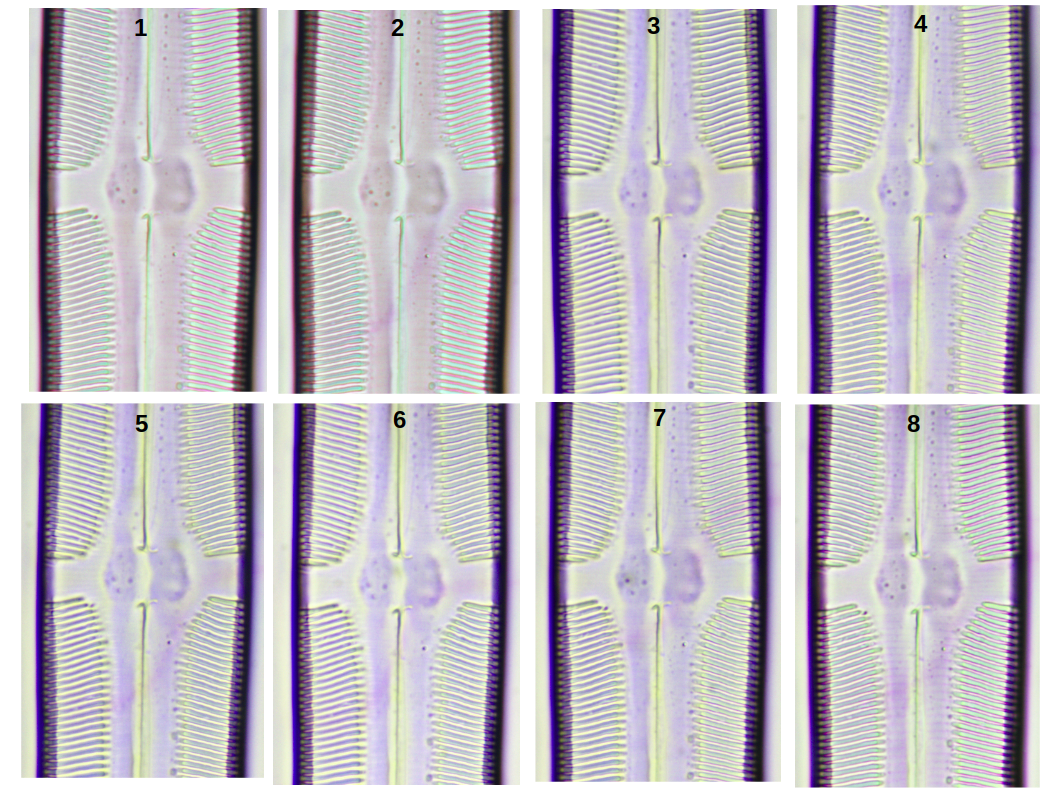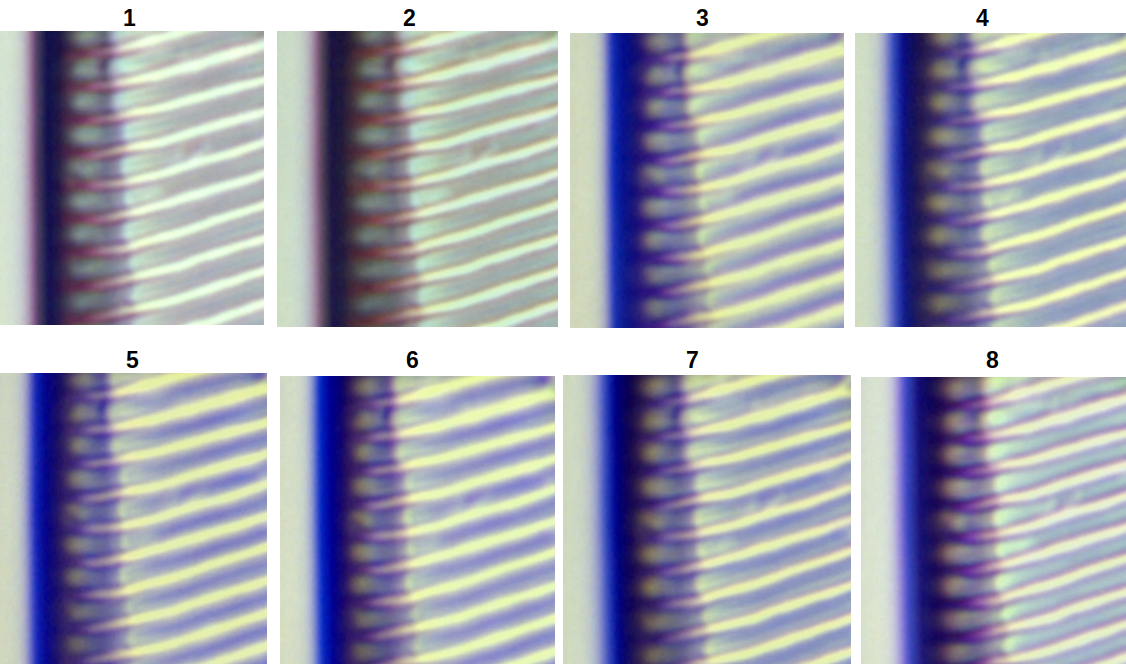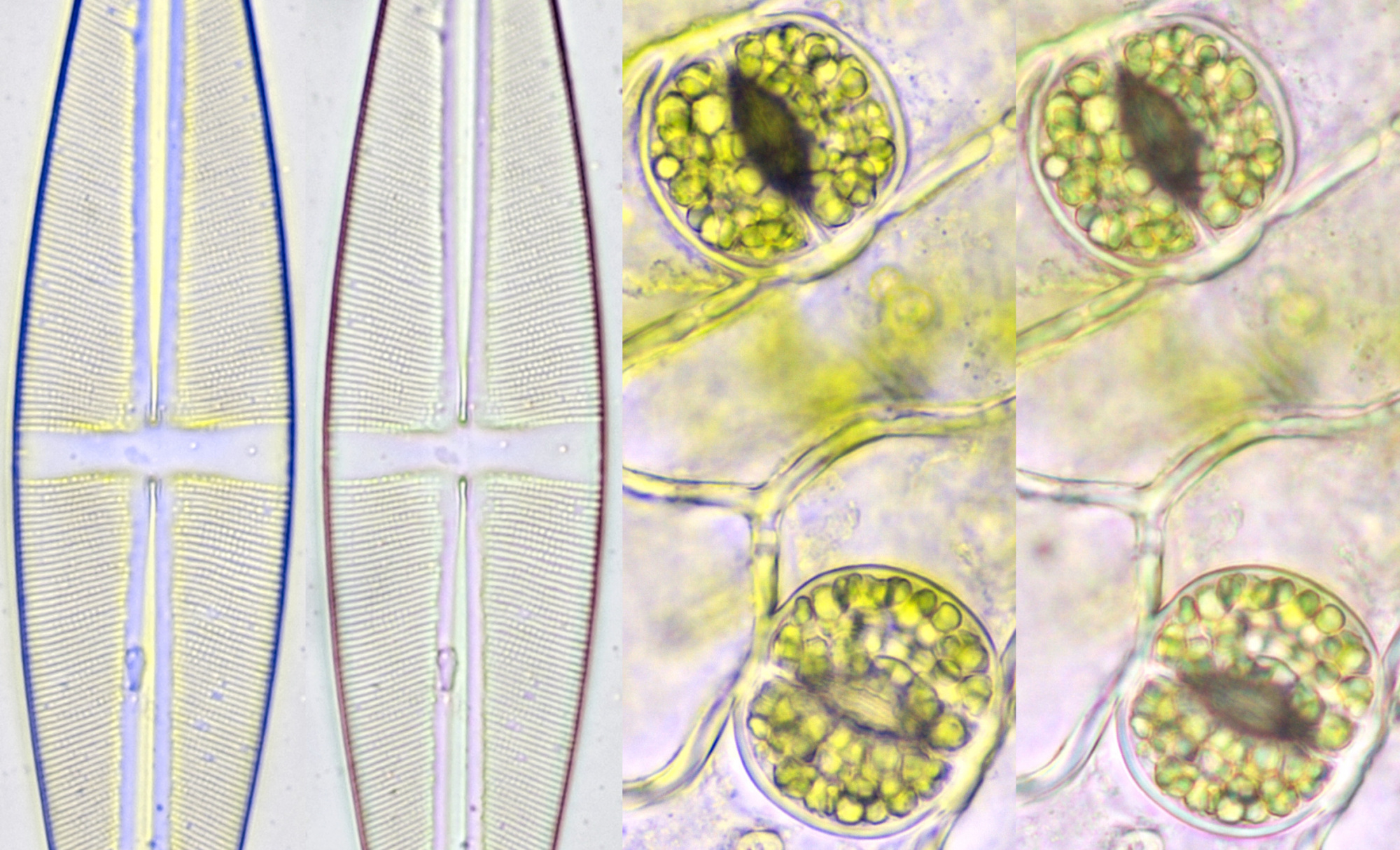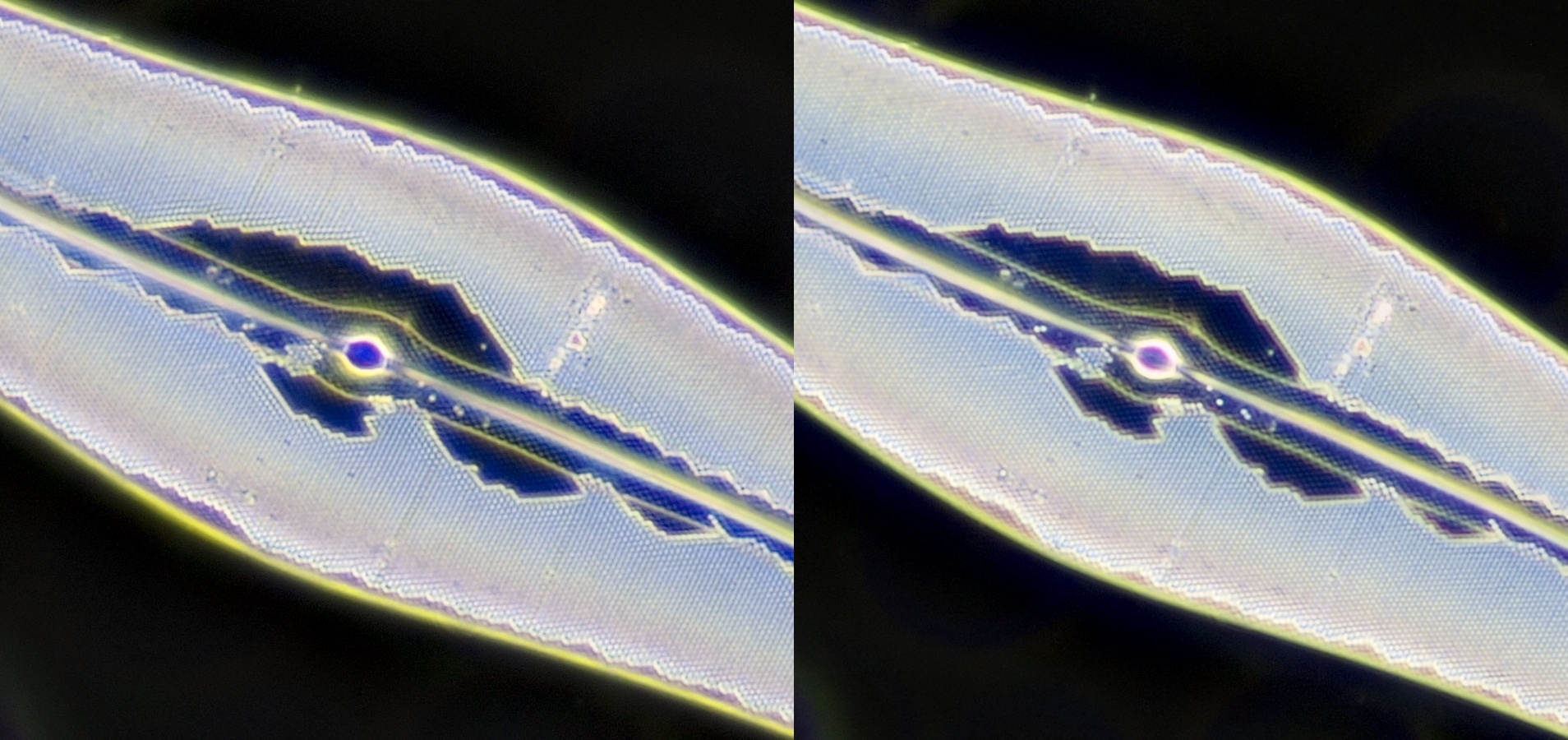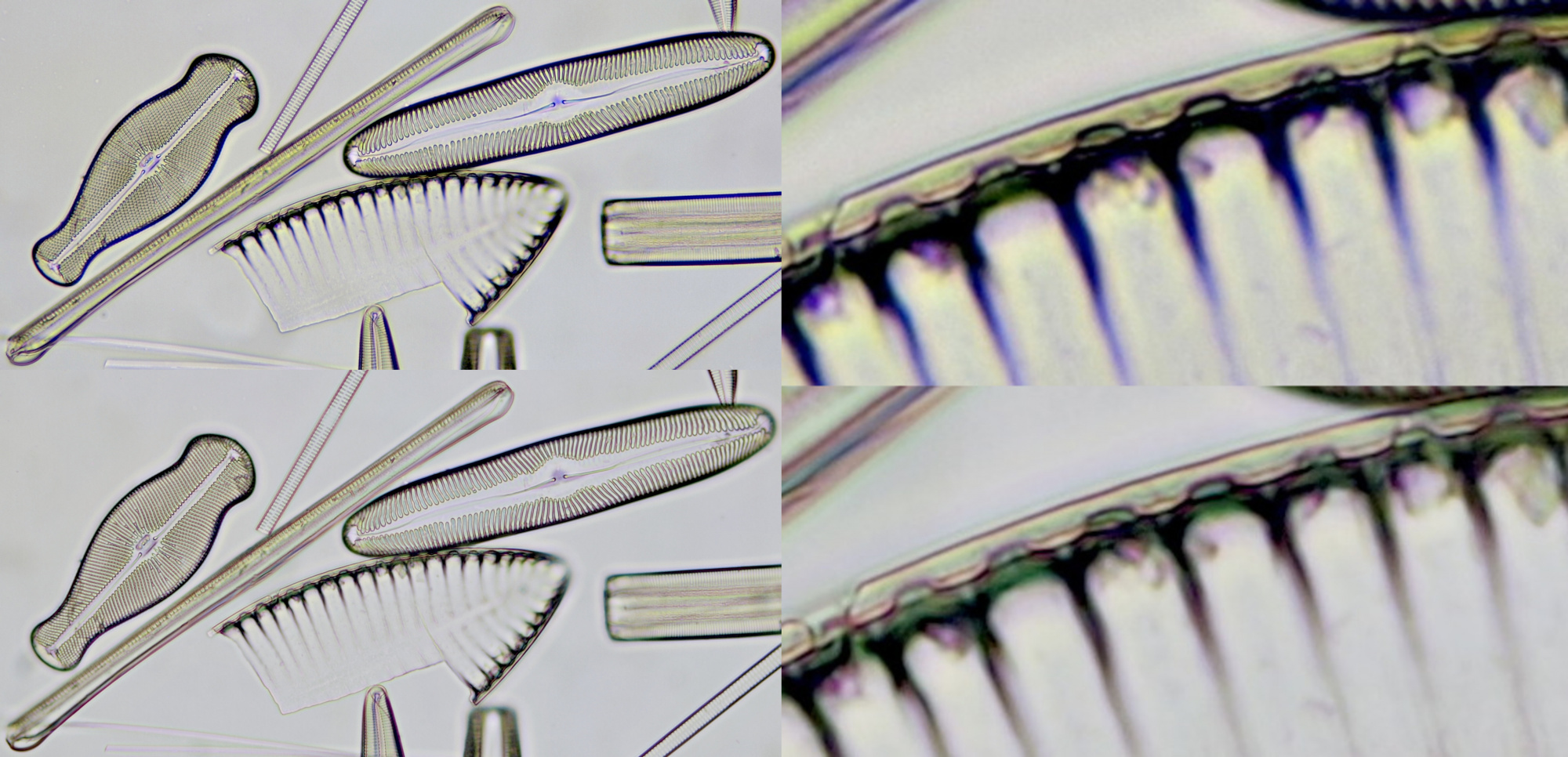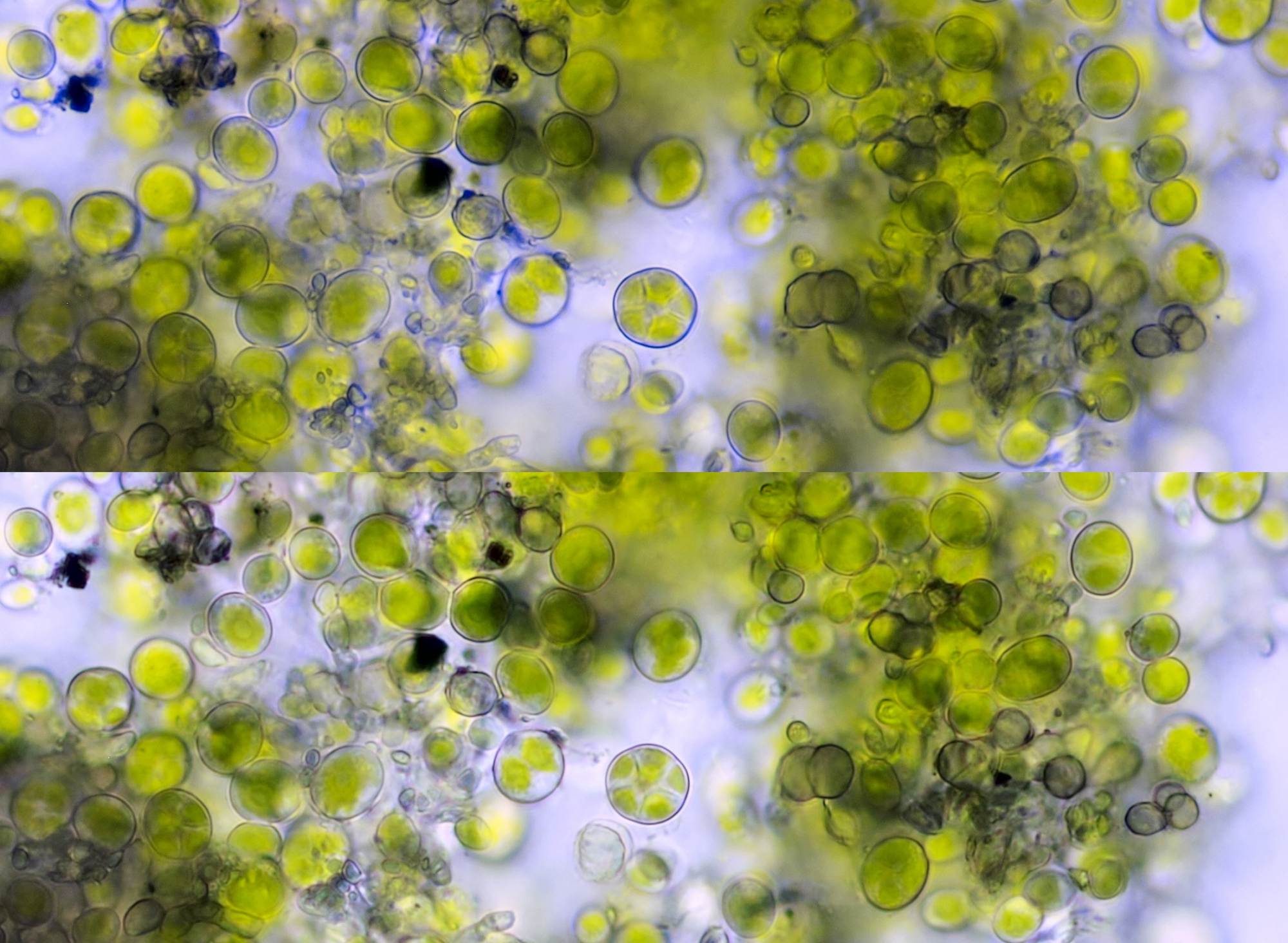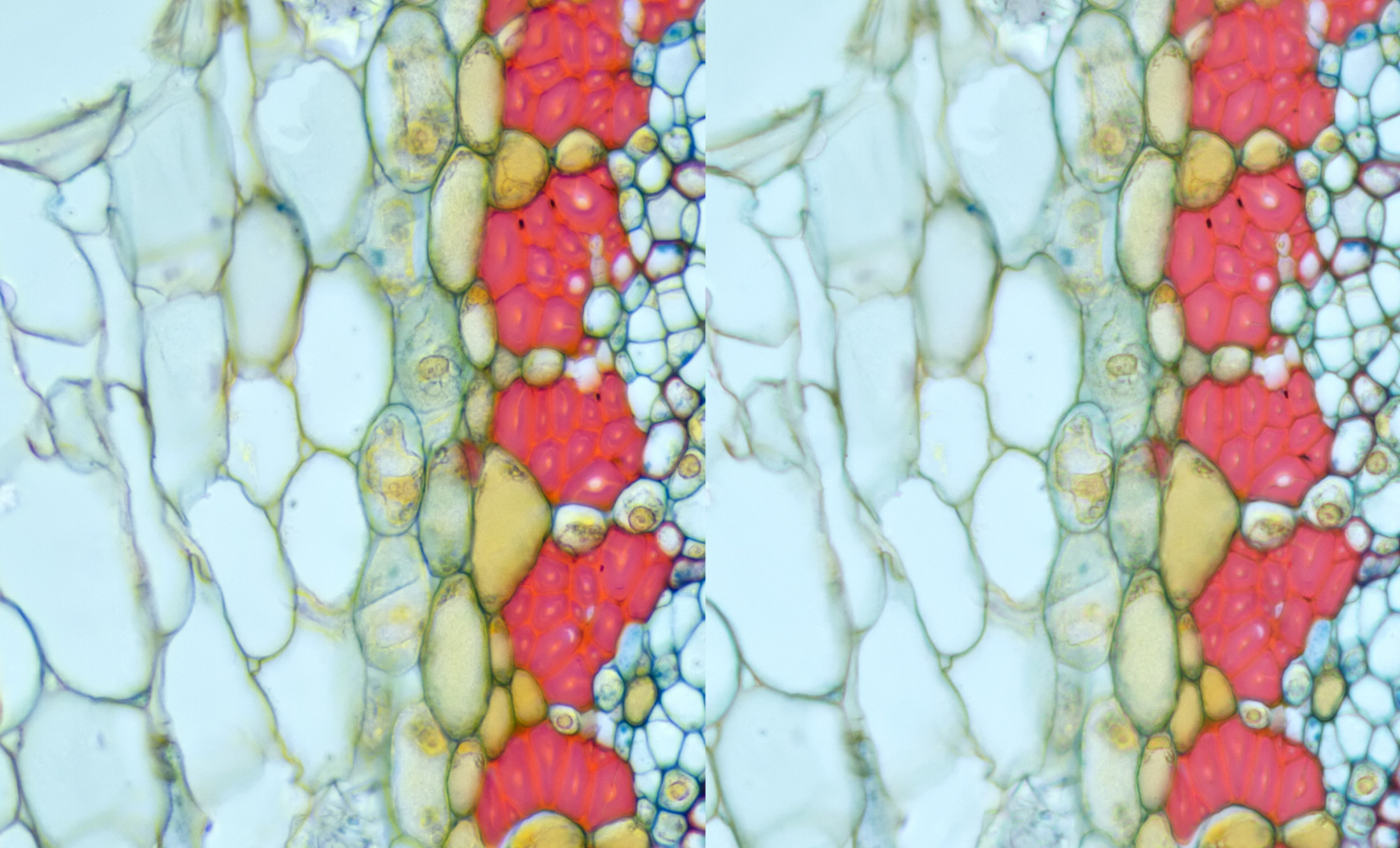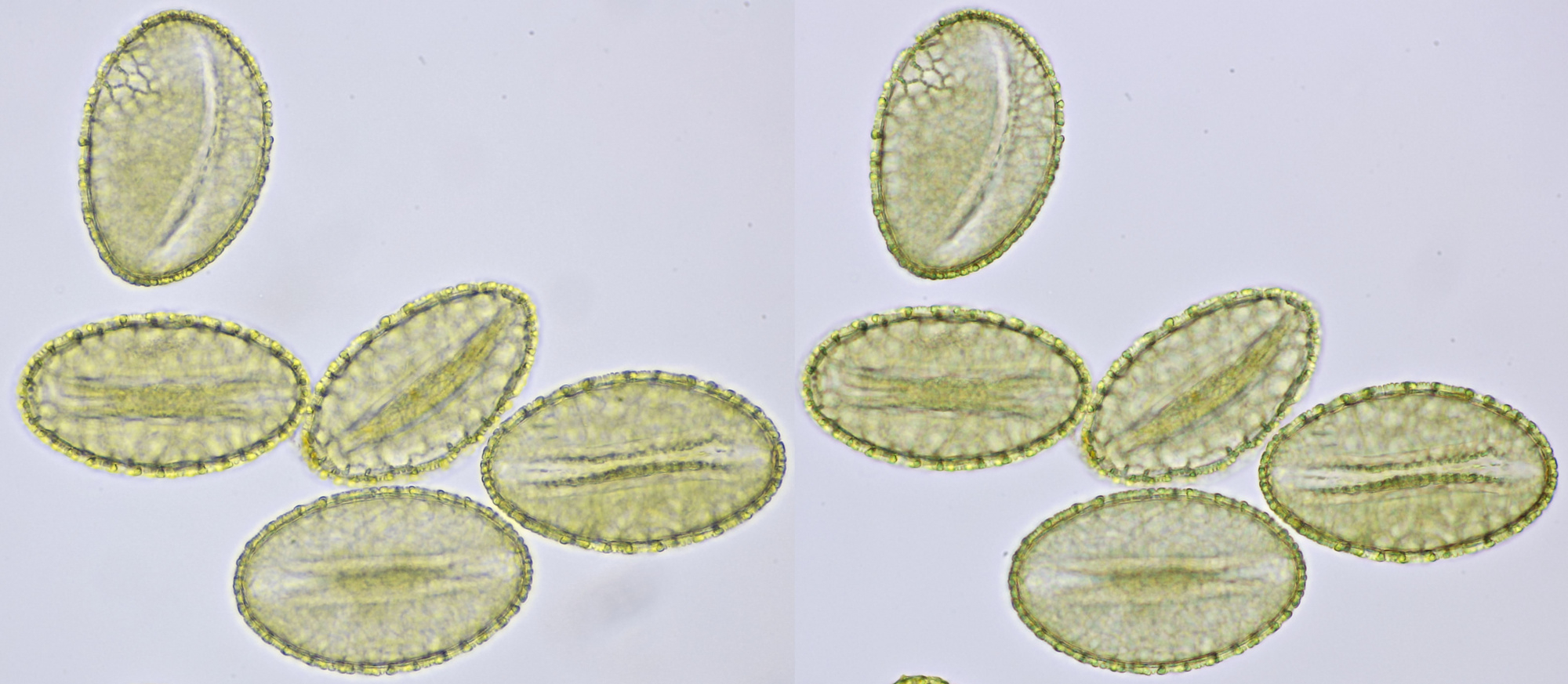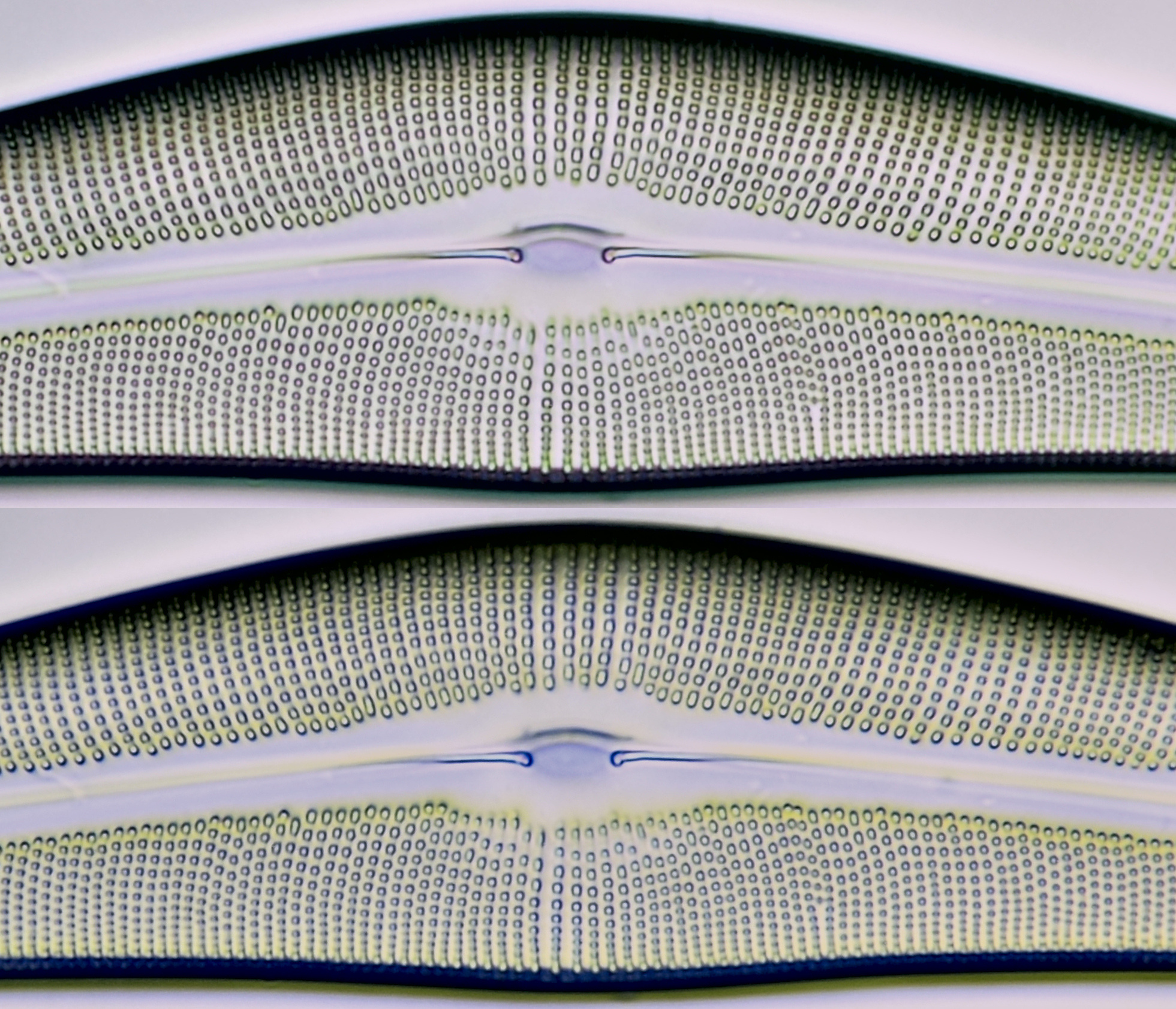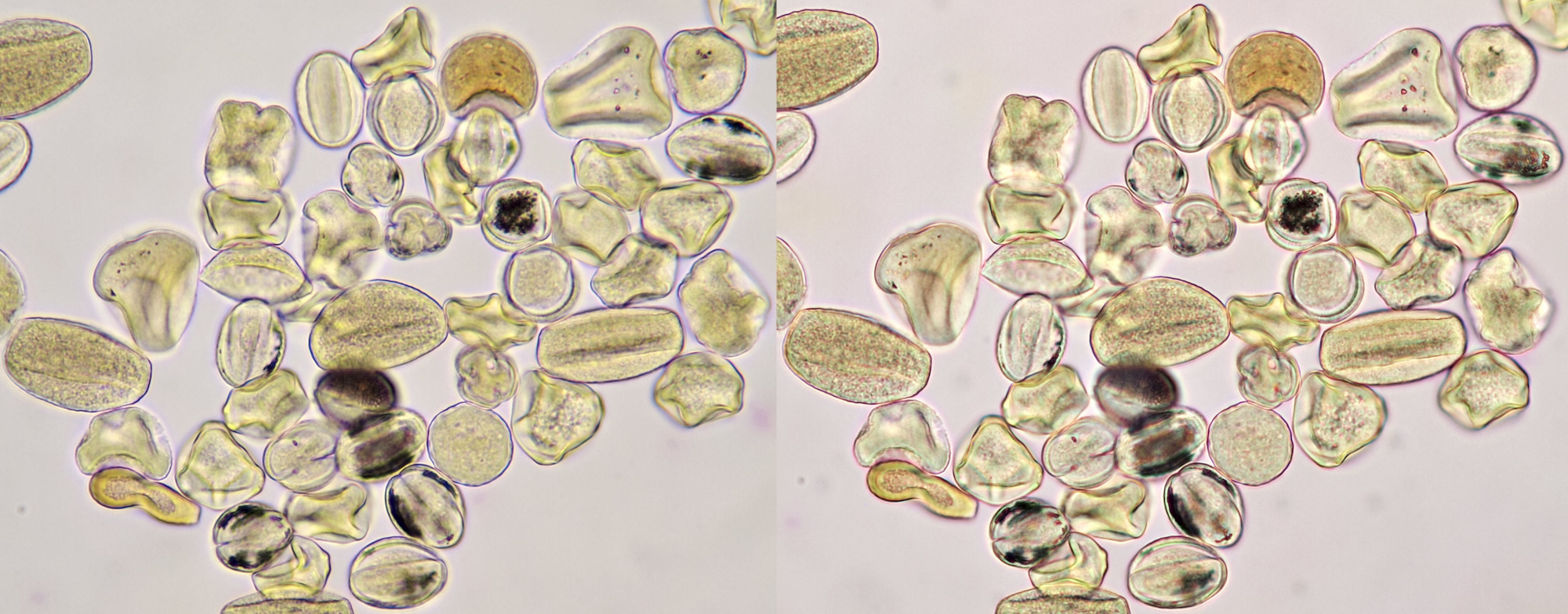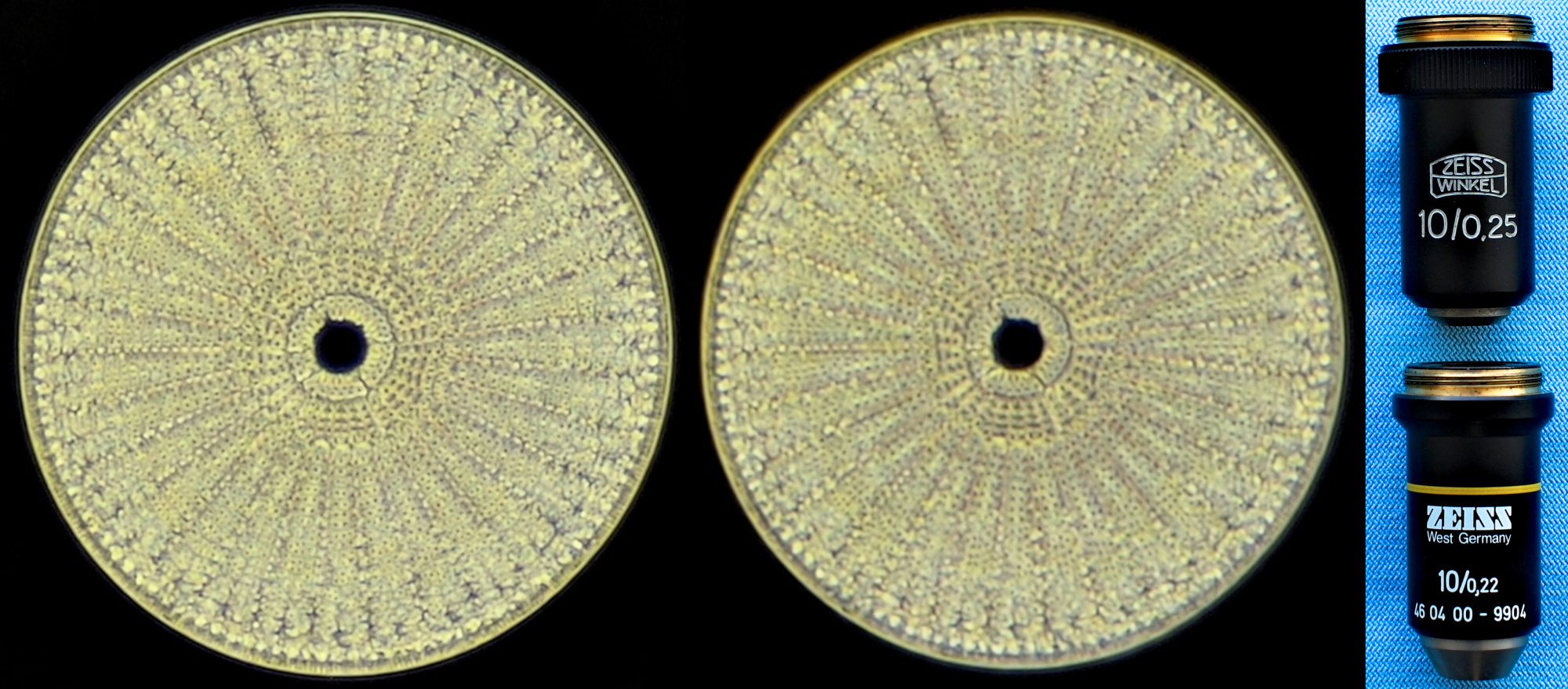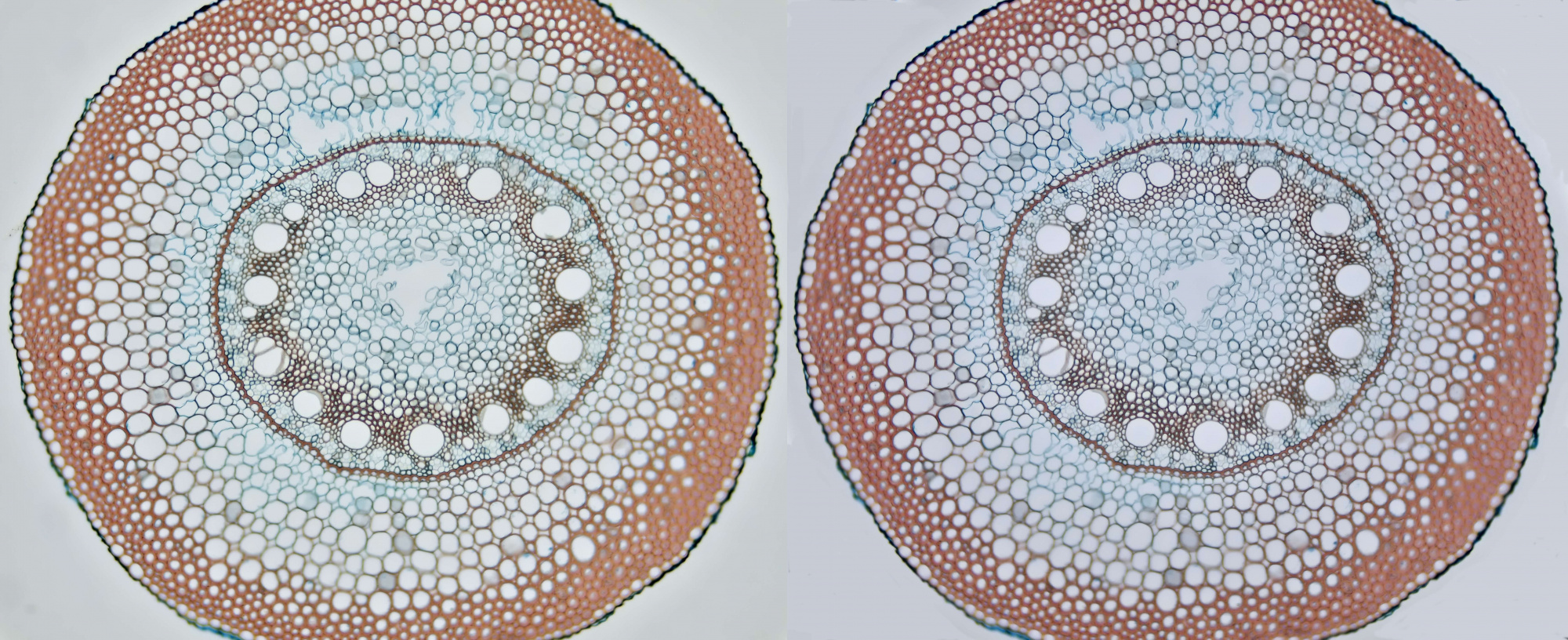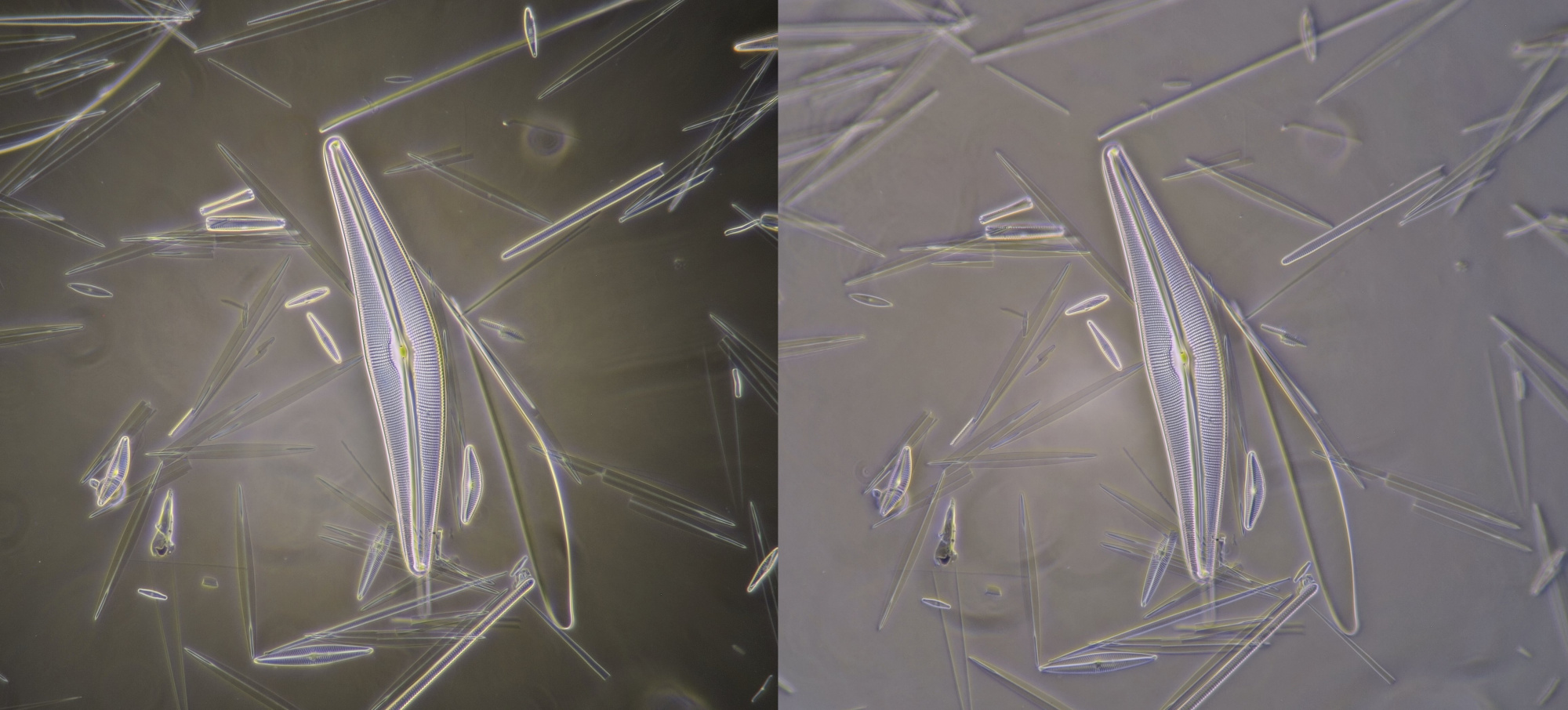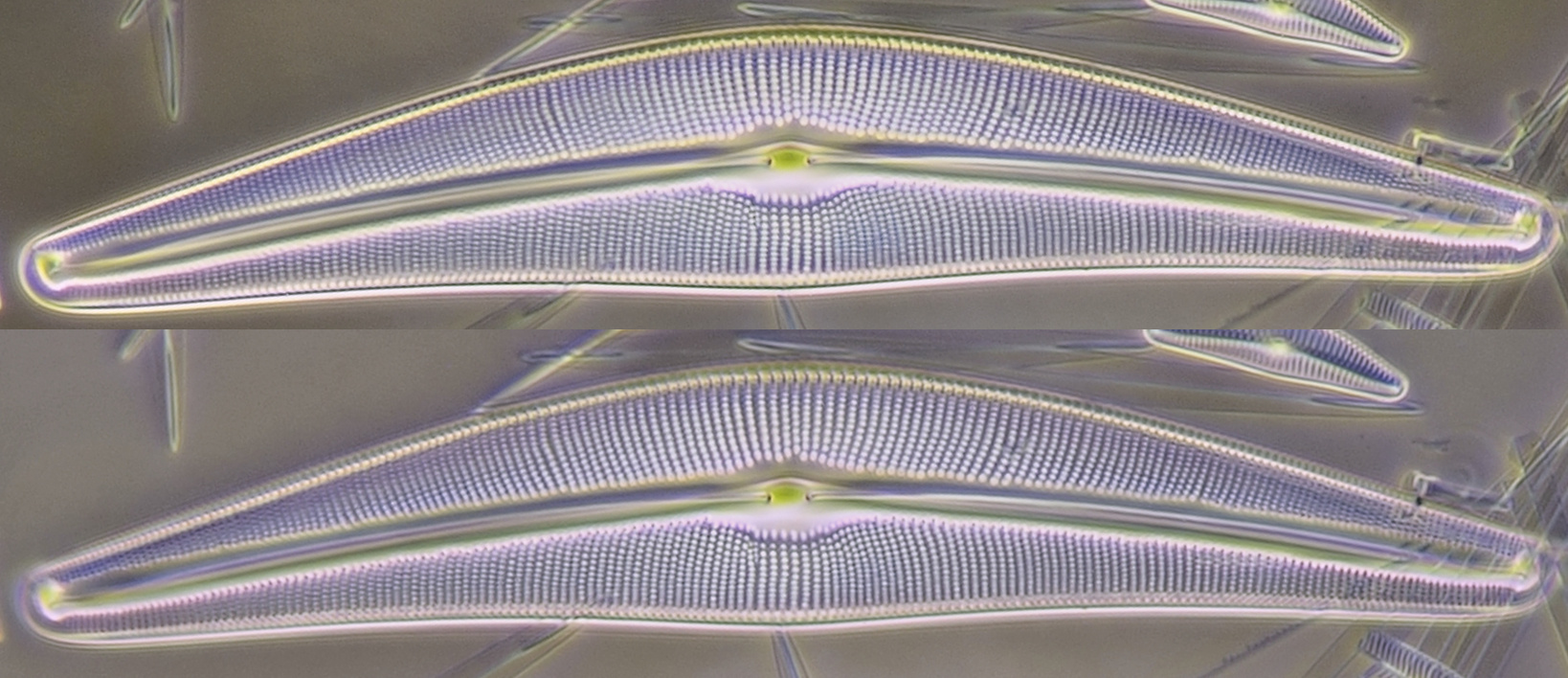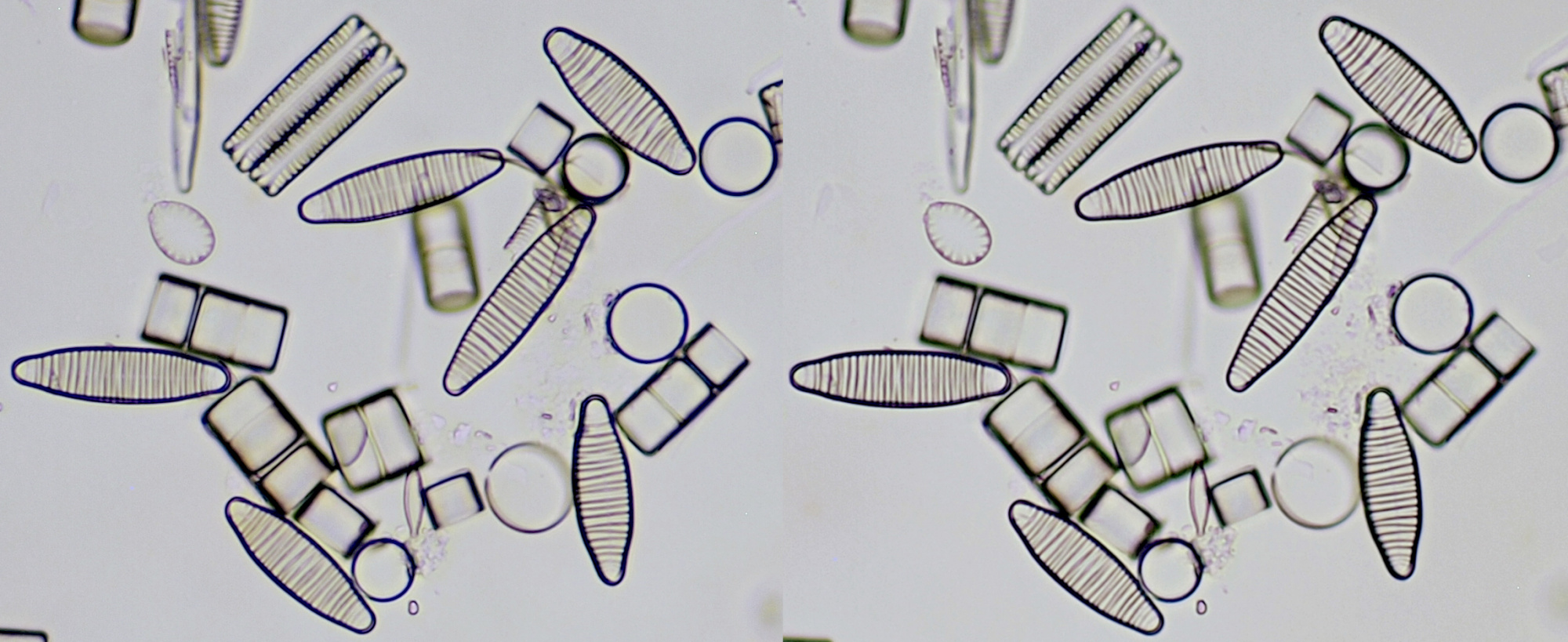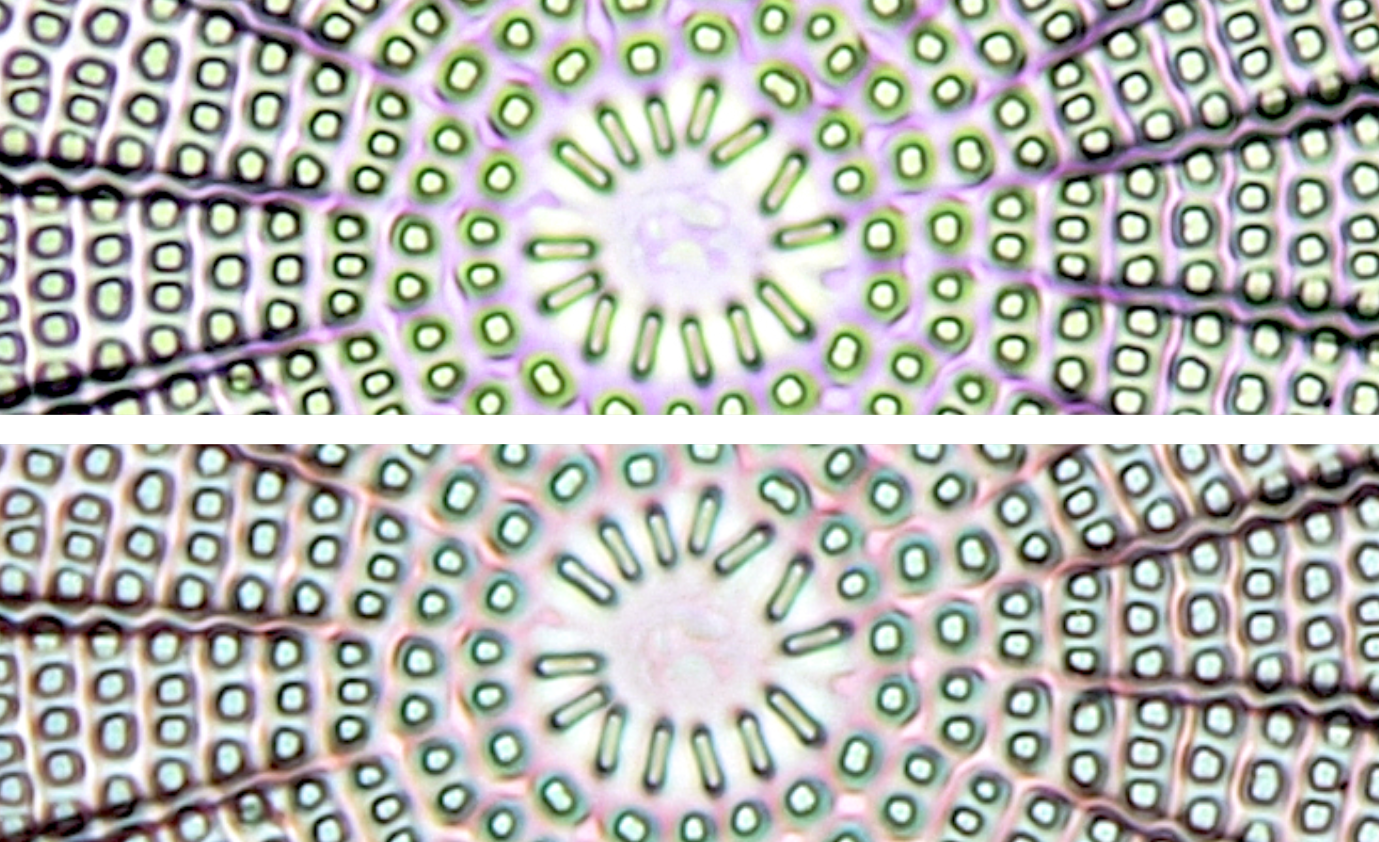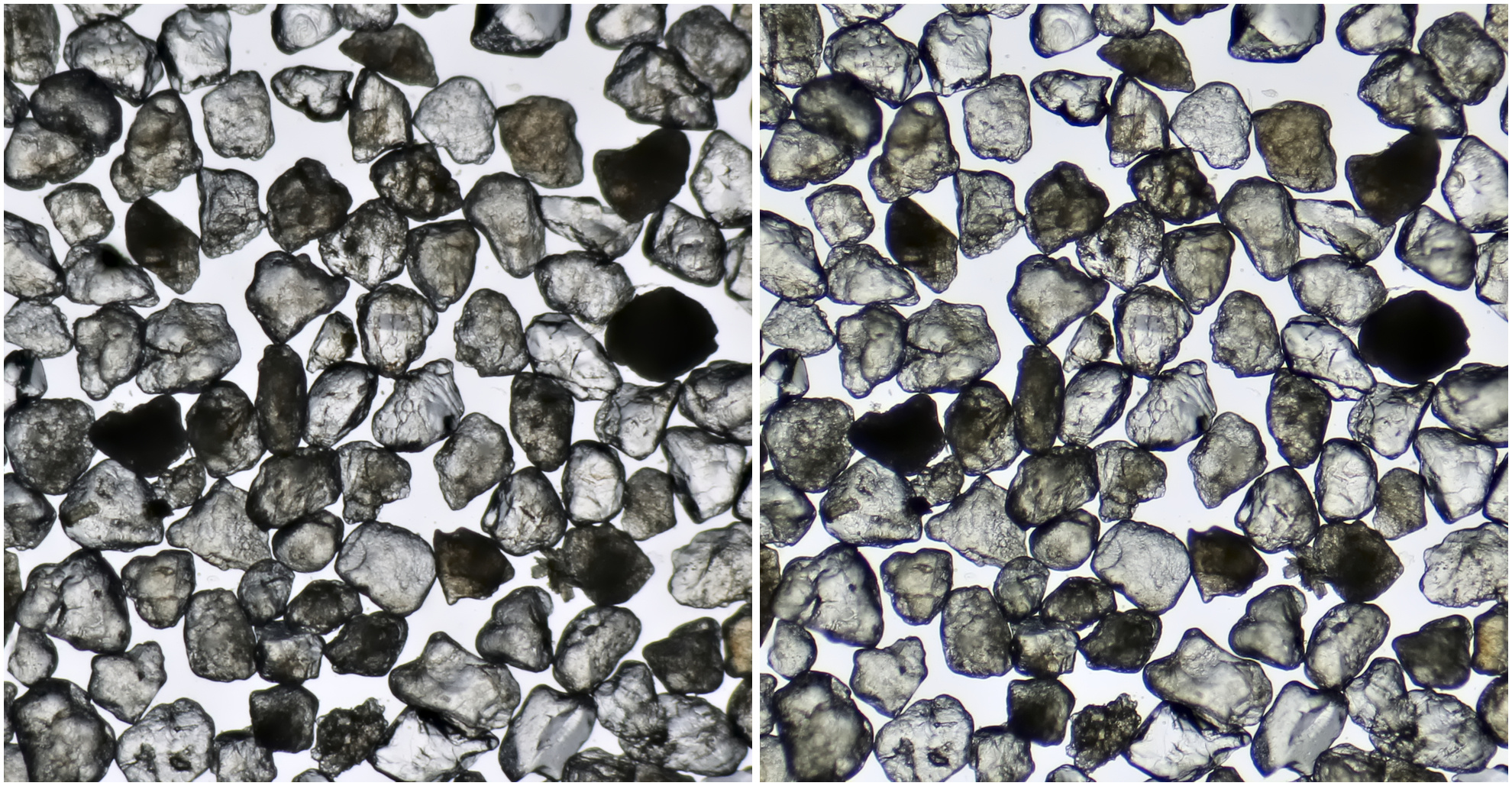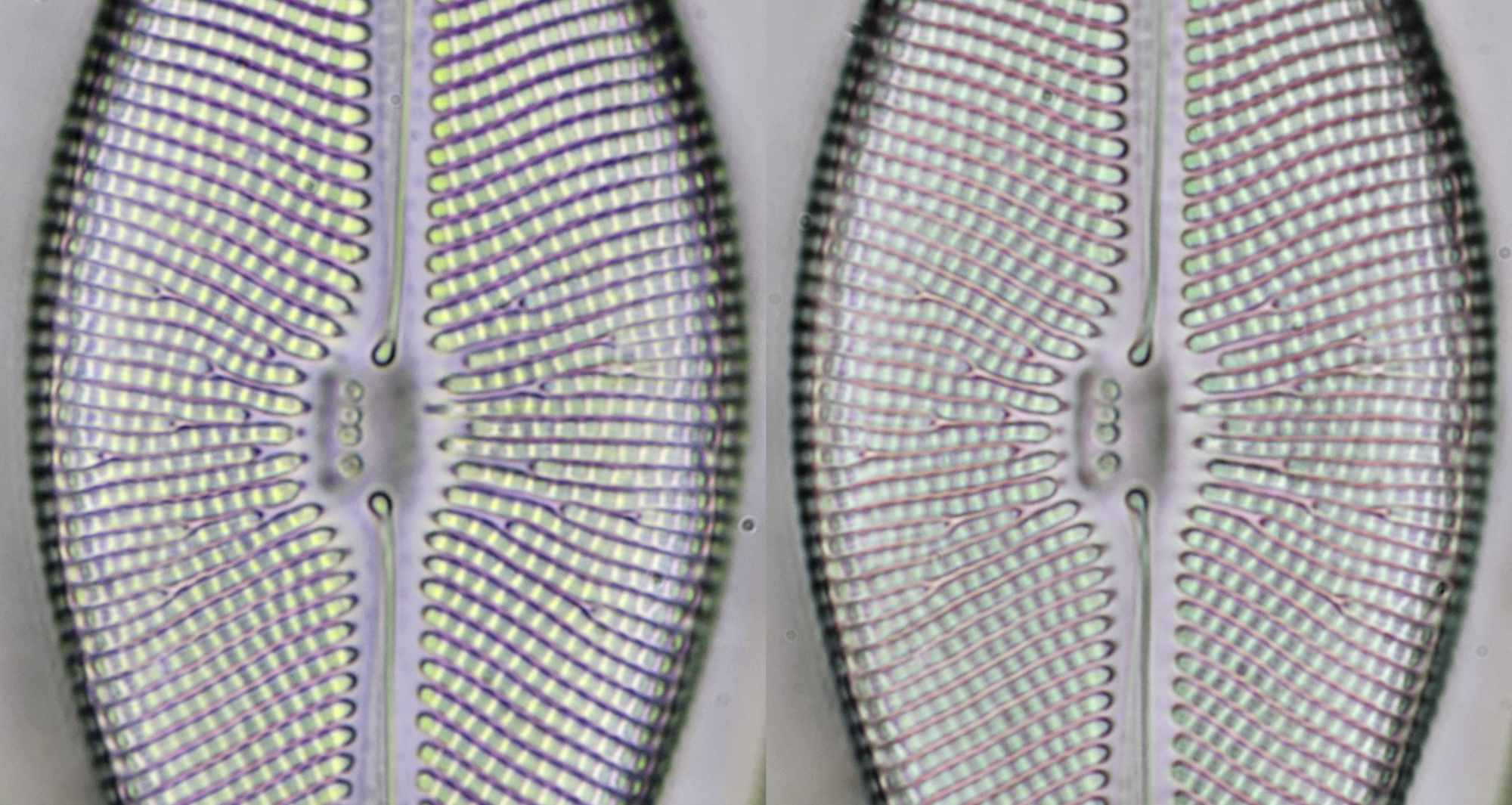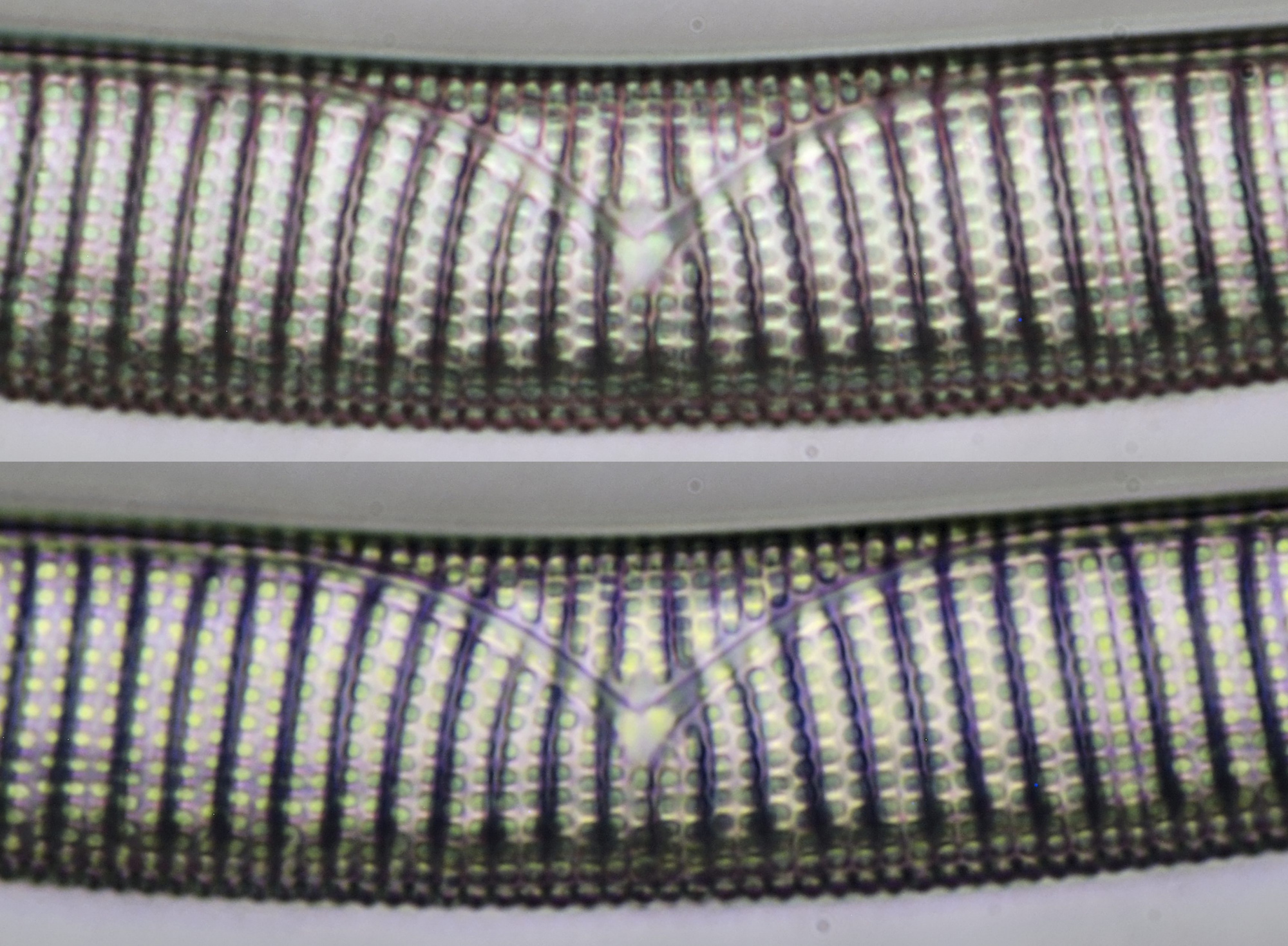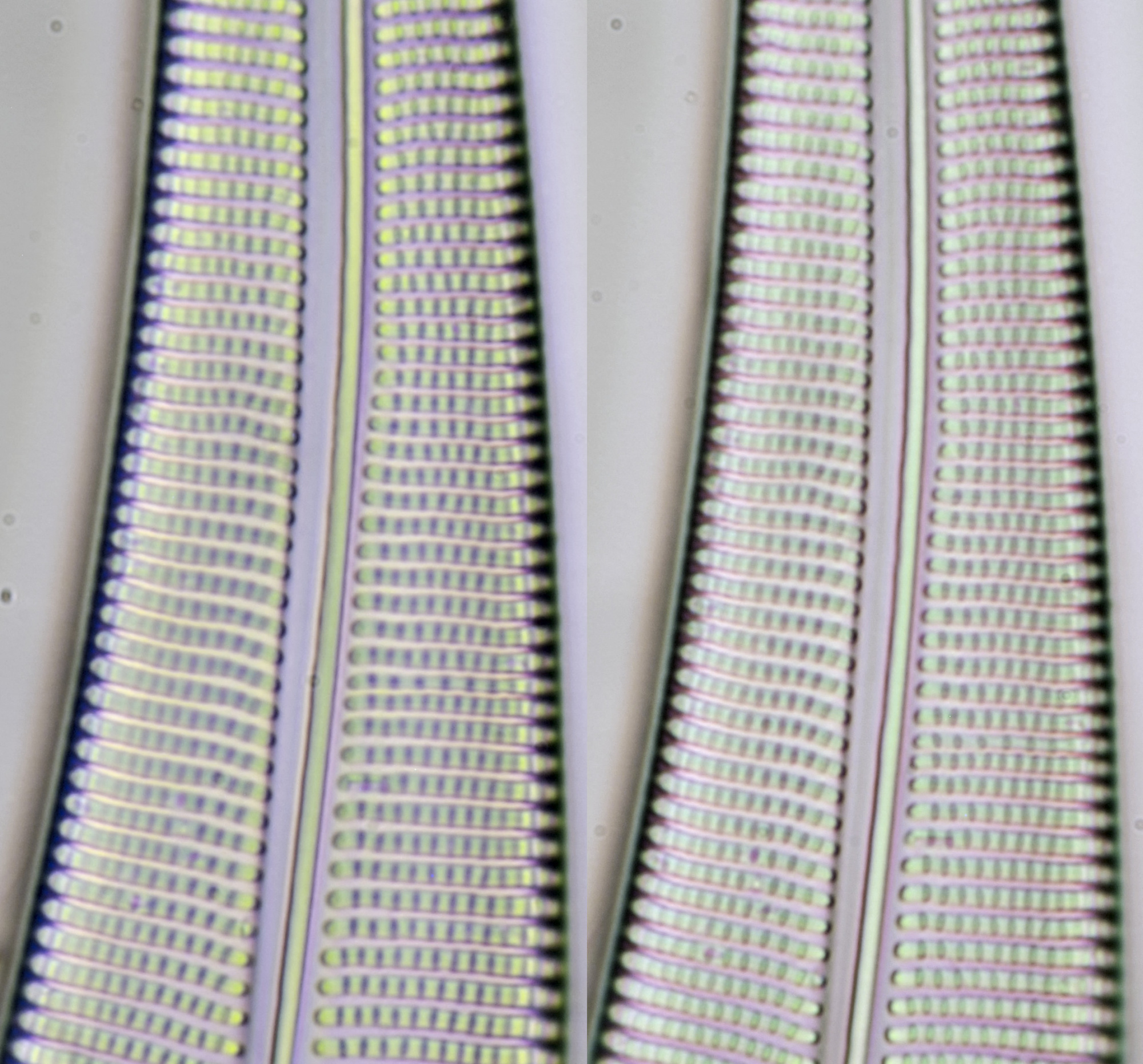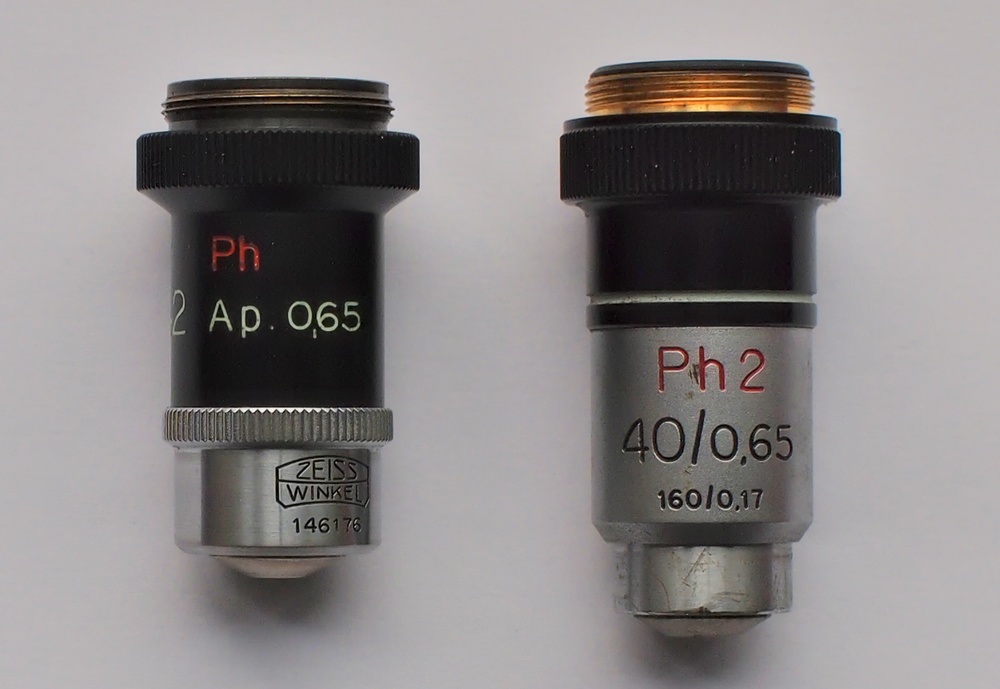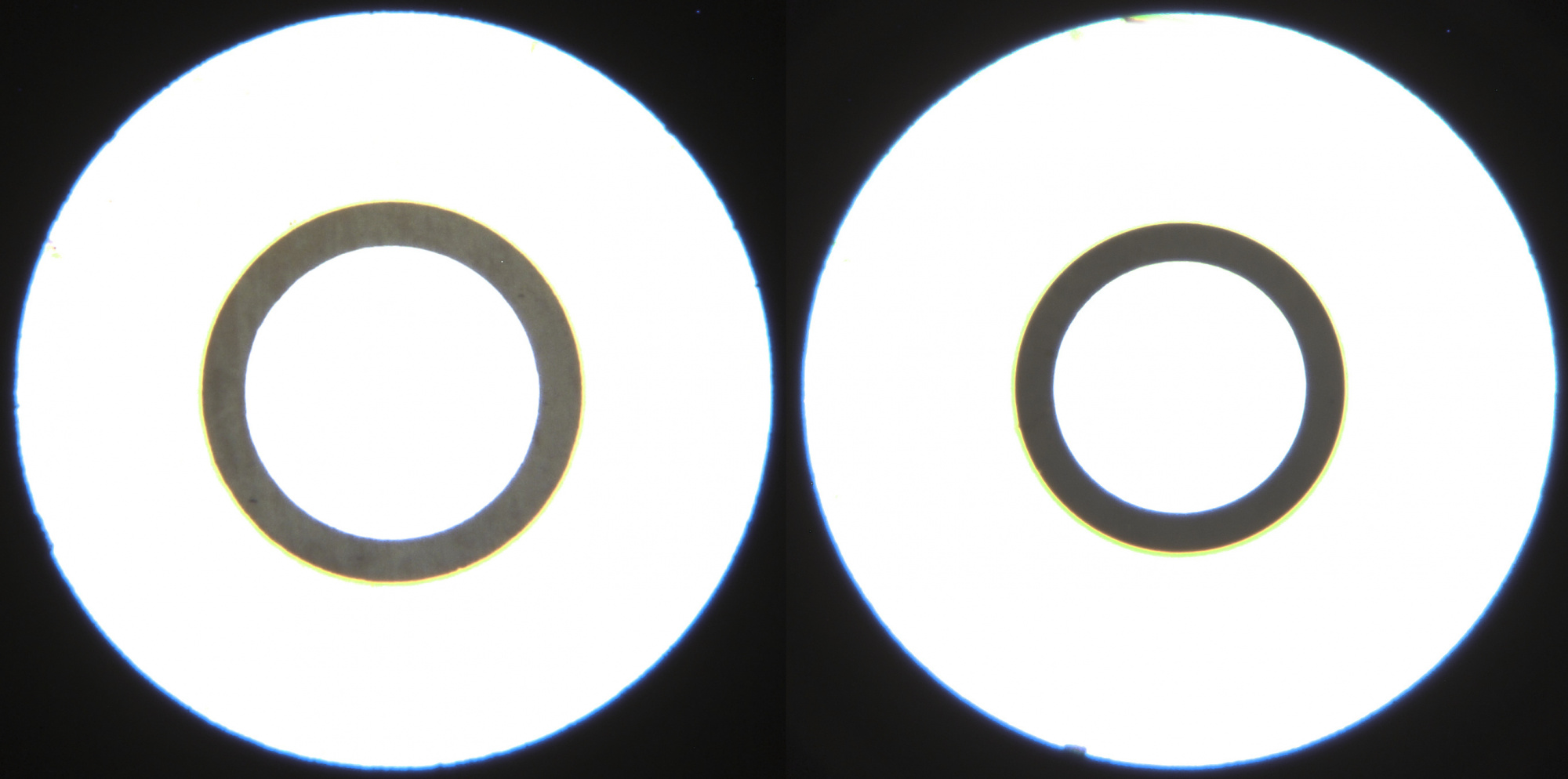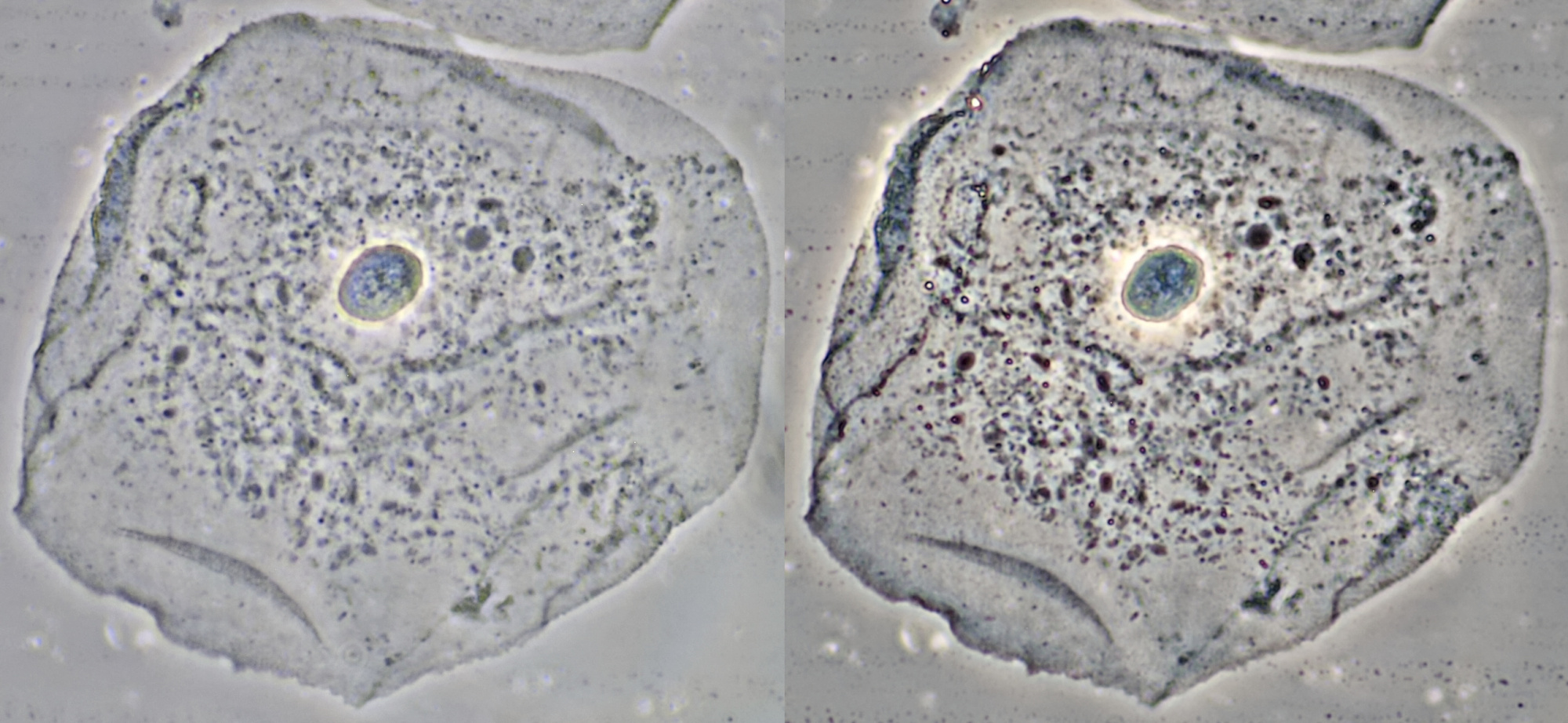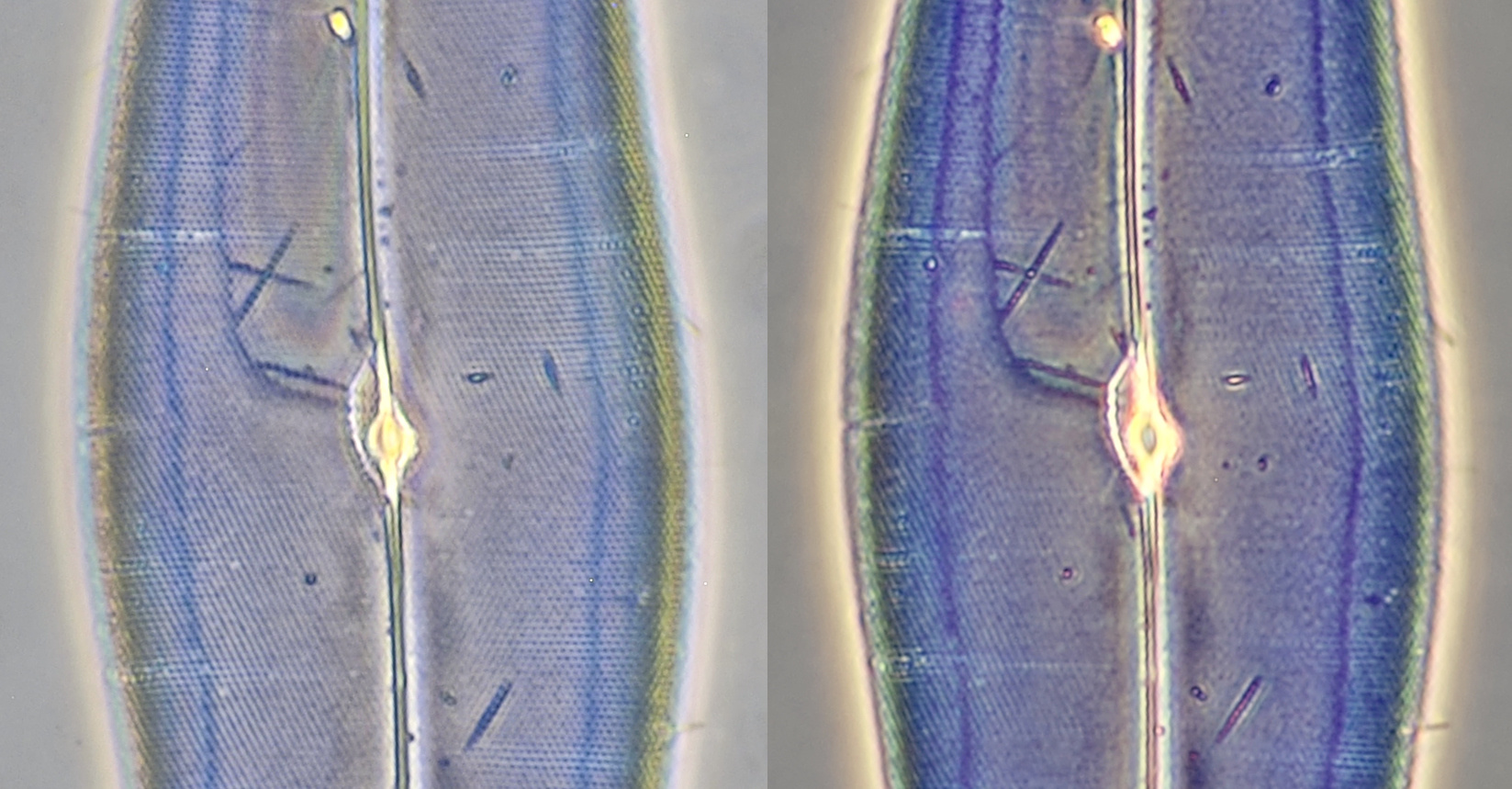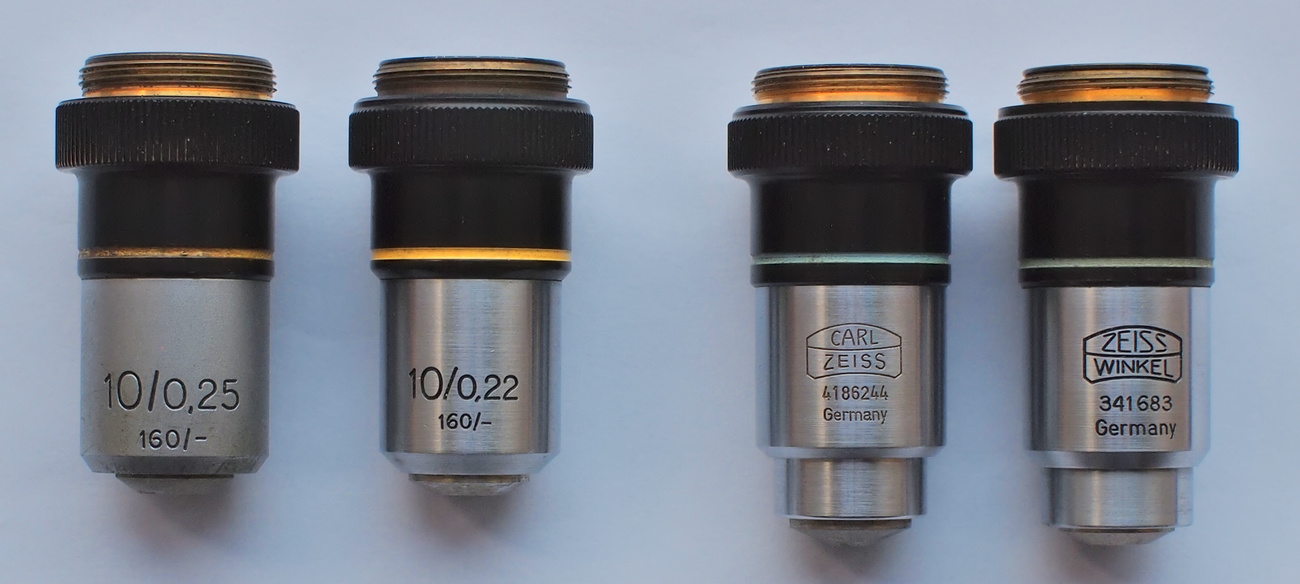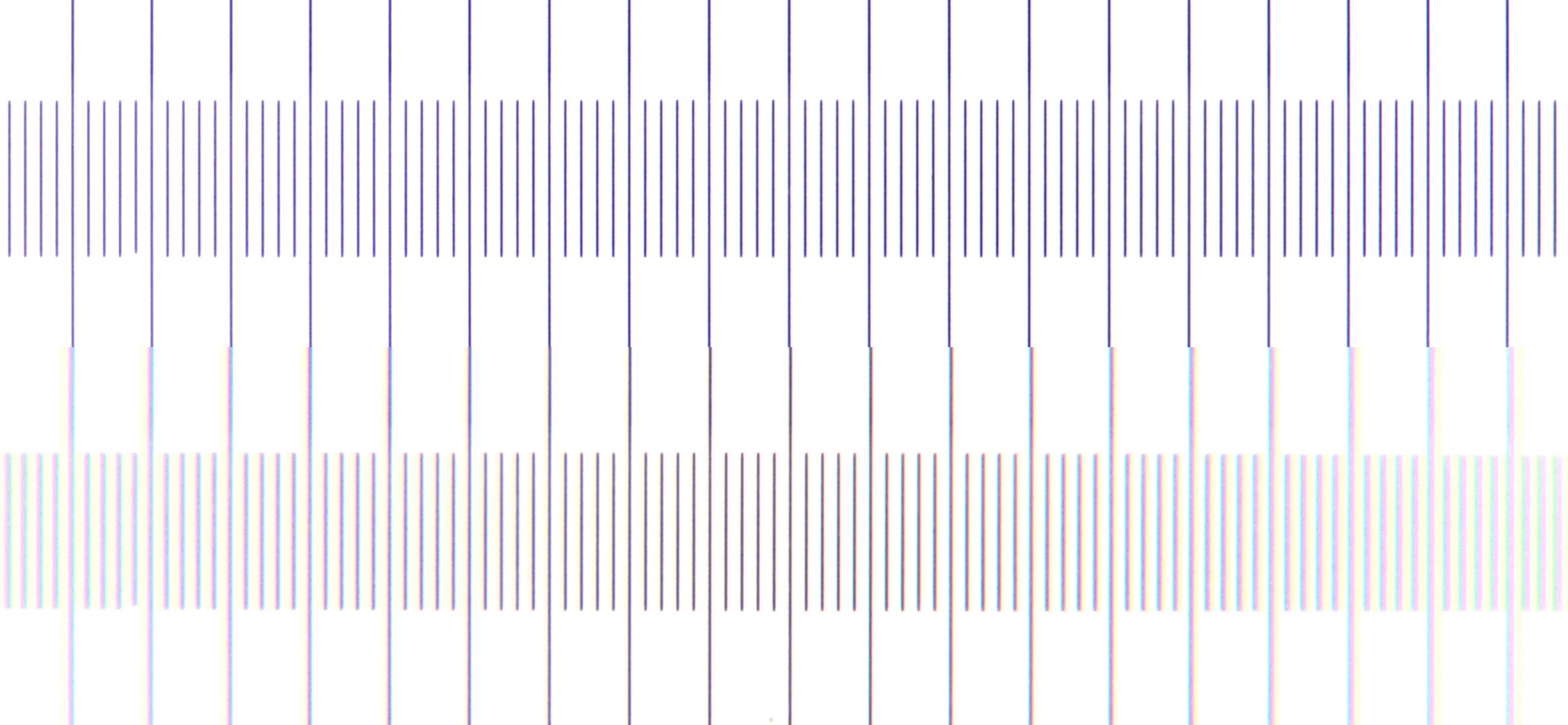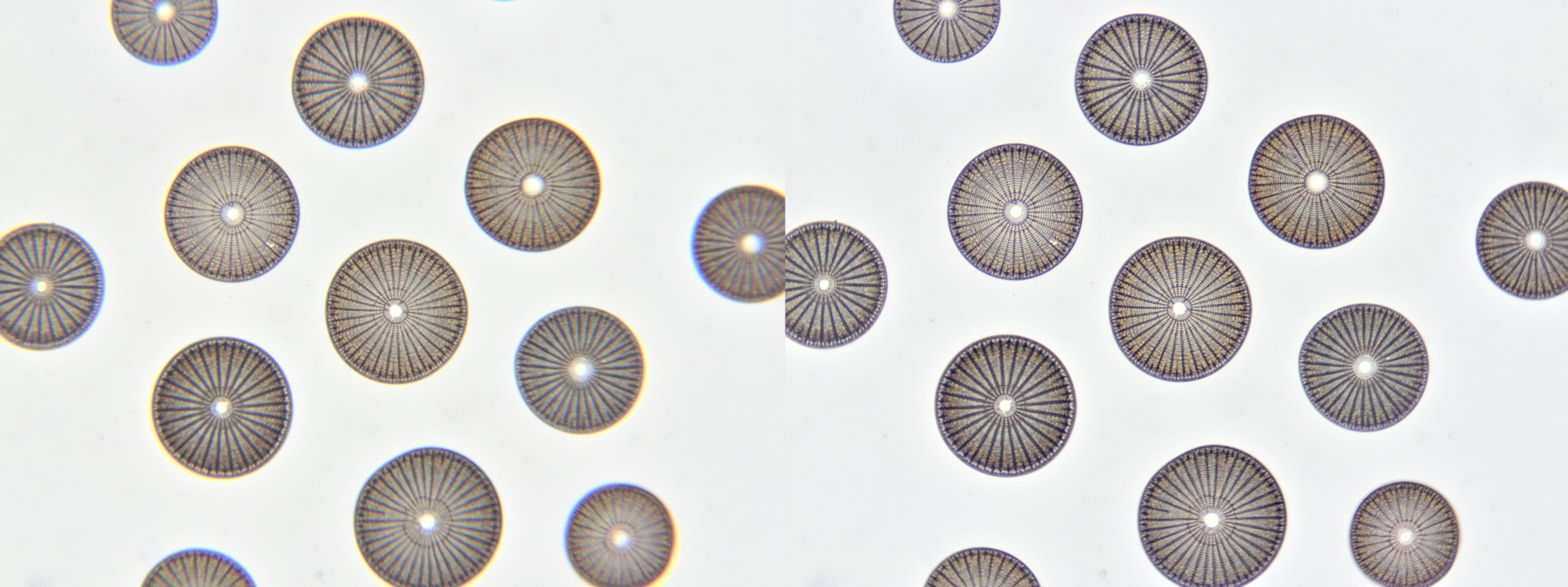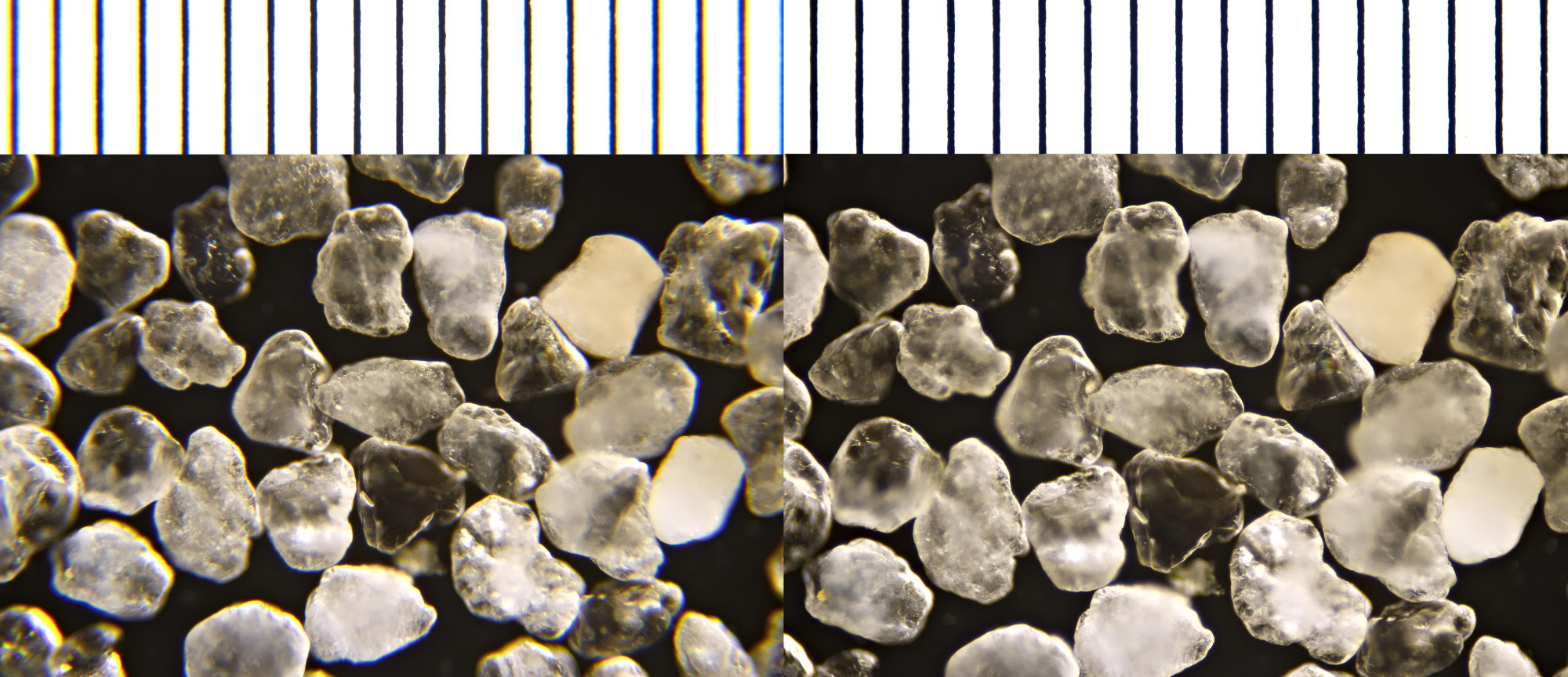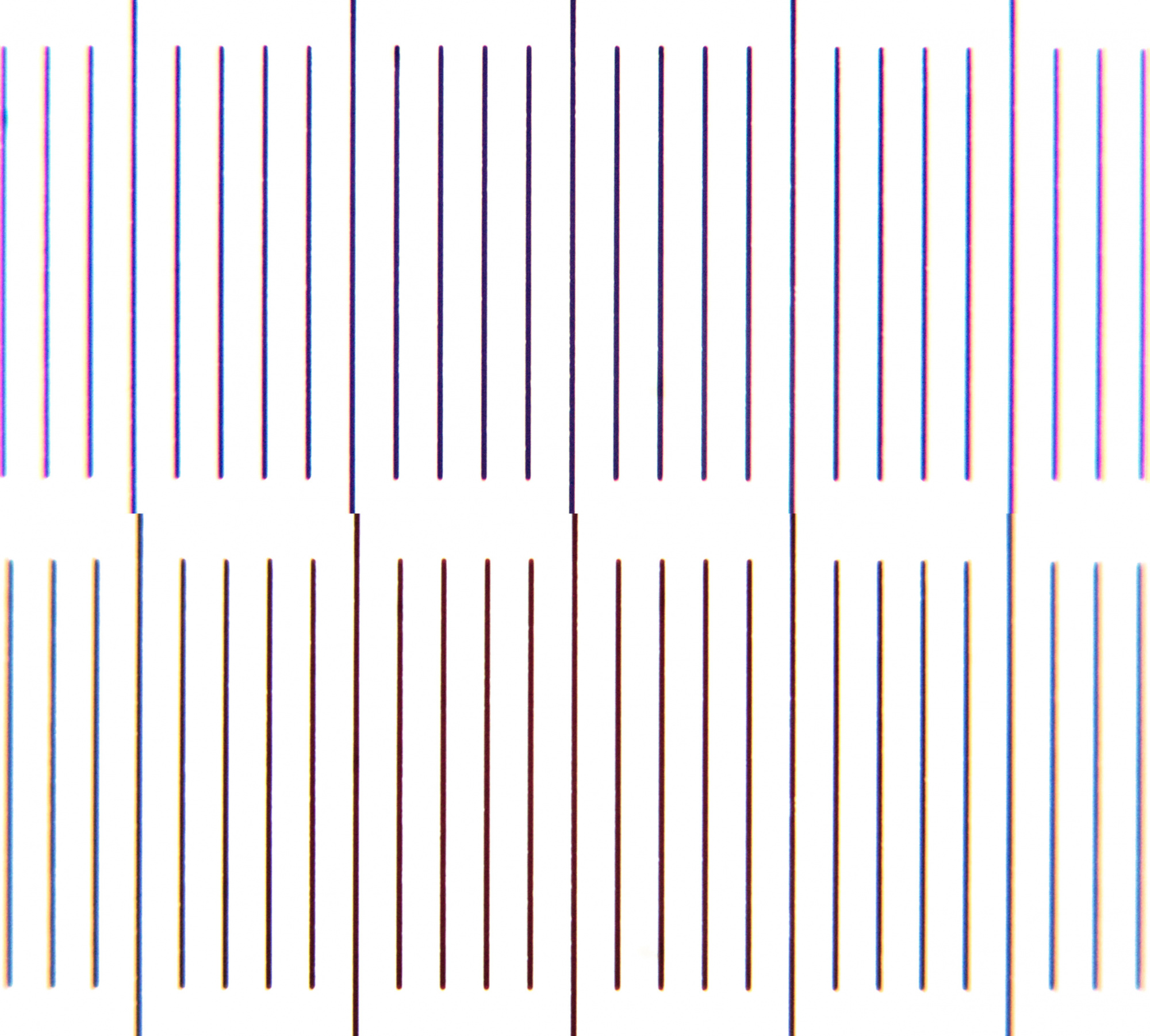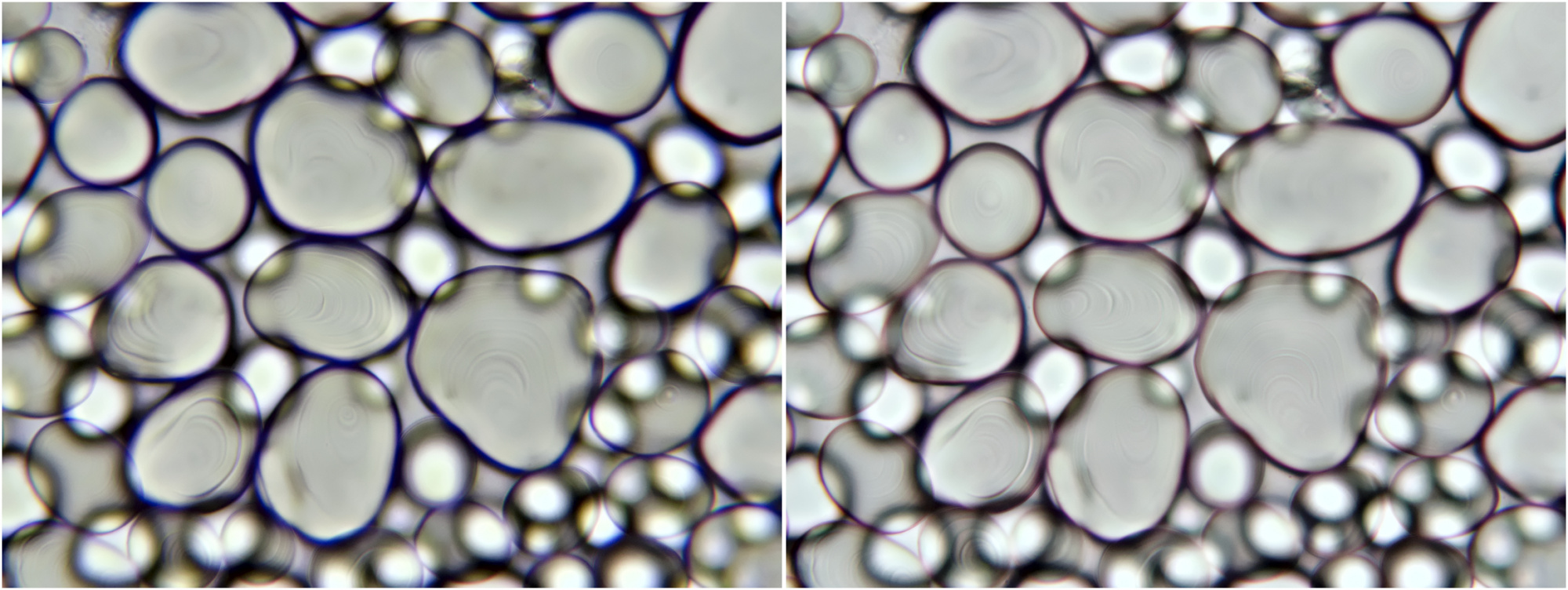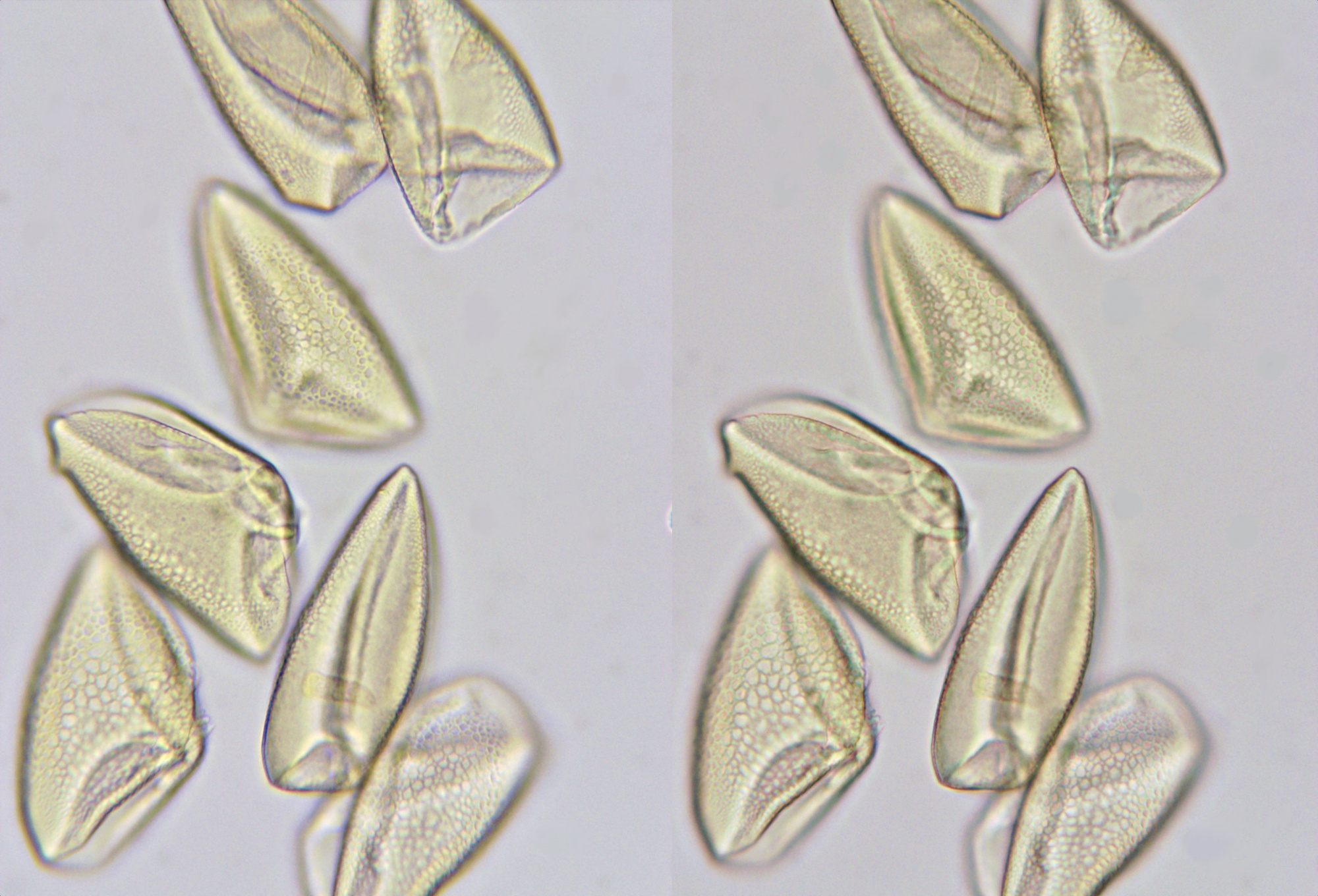Achromats are the most simple lenses where the chromatic aberration is corrected for only two colours: blue and red. This means that some residual colour may still be present in the microscopic image as an artifact. I found out that the degree to which this residual colour appears is different between the achromats from (Carl) Zeiss and Zeiss-Winkel. The tests described on this page were done with 45 mm parfocal objectives that were calculated for a mechanical tube length of 160 mm. The first objectives with 45 mm parfocal lenght to be produced in a Zeiss factory were made by Zeiss-Winkel in Göttingen during the late 1940s. At the end of the 1950s Zeiss-Winkel became Carl Zeiss and the optical facilities were relocated to Oberkochen. In later years the name ‘Carl’ was dropped and optics were simply labeled as ‘Zeiss’. At the same time, in former East Germany, there was a separate production facility under the name ‘Carl Zeiss Jena’ (CZJ). In this article, the name ‘Zeiss’ refers to the objectives from Carl Zeiss, Carl Zeiss Jena and Zeiss.
Achromats 40/0.65
The achromats used here concerns the objectives with 45 mm parfocal length and 160 mm mechanical tube length from Zeiss and Zeiss-Winkel. For the comparisons I used different kinds of slides and it is striking that the colour of the residual chromatic aberration is different between Zeiss-Winkel and Zeiss. With Zeiss-Winkel objectives, this colour is pink, whereas with Zeiss objectives, blue fringes are seen. The pink coloured fringes from Zeiss-Winkel objectives are much less present than the bright blue colour that is seen with Zeiss optics. The result of this is that images taken with Zeiss-Winkel objectives appear more neutral, so the artifacts are less obvious. Apparently, Zeiss-Winkel used a different kind of compensation to correct for the residual aberration in the objectives. I have the impression that Zeiss-Winkel achromats generally produce less colour artifacts than all other later Zeiss achromats. It is surprising how good these 70-year-old lenses already were. Perhaps Zeiss-Winkel used a different type of glass. Zeiss-Winkel also produced the first Neofluar objectives. These lenses are well known for their better correction and brilliant images. The older Zeiss-Winkel objectives do have more field curvature, but I have never found that really disturbing; the object of interest is usually located in the center of the field of view anyway. When photography with achromats is concerned, I certainly prefer Zeiss-Winkel.
Zeiss-Winkel and Zeiss 40/0.65 achromats arranged chronologically from the late 1940s (1) to the late 1990s (8).
1: Zeiss-Winkel, first 45 mm version, late 1940s
2: Zeiss-Winkel, 1950s
3: aus Jena
4: Carl Zeiss
5: Carl Zeiss
6: Zeiss
7: Zeiss F40
8: Zeiss Plan40
Pinnularia, photographed with the different 40/0.65 achromats.
Crops from the previous images, the differences in colour artifacts become more visible.
The difference between Zeiss and Zeiss-Winkel can also be clearly seen with other objects.
From left to right: Stauroneis, photographed with Carl-Zeiss 40/0.65 (number 5) and Zeiss-Winkel 40/0.65 (number 2) and stomata of Hosta photographed with Zeiss 40/0.65 (number 6) and Zeiss-Winkel 40/ 0.65 (number 1).
At first it seems that the photos taken with Zeiss-Winkel lenses have less contrast than the other images. However, I think that the darker blue colour fringes seen with Zeiss objectives partly enhance the contrast because this colour is more present than the pink colour from Zeiss-Winkel.
Darkfield images of Pleurosigma angulatum. Photographed on the left with Zeiss 40/0.65 (number 6) and on the right with Zeiss-Winkel 40/0.65 (number 1). The blue colour artifacts are less present in the image taken with the Zeiss-Winkel objective. In addition, the structure seems better resolved with the Zeiss-Winkel. I also saw this with bright field images.
Comparison between the oldest and most recent objective in the series. Above: Zeiss Plan 40 (number 8). Below: Zeiss-Winkel 40 (number 1). In the cropped images on the right, the difference with respect to the colour artifacts is clearly visible.
The green algae Pleurococcus. Upper image: Carl Zeiss 40 (number 4). Lower image: Zeiss-Winkel 40 (number 2). In the upper image, clear blue coloured edges can be seen.
Section of a stained slide from a stem of Tilia. Left: Zeiss 40 (number 6). Right: Zeiss-Winkel 40 (number 2) gives a more neutral image.
Pollengrains from lily. Left: Carl Zeiss 40/0.65 (number 5). Right: Zeiss-Winkel 40/0.65 (number 1). The left image contains more blue residual colors while the right image contains more green tones, which I find less disturbing. The photo on the right makes a better impression as a whole in my opinion, also in terms of contrast. To better see the differences, click on the picture to enlarge.
The next tests are comparisons between the oldest lens in the series, the black Zeiss-Winkel 40 and the much later Zeiss F40 with semi-plan correction. Here too, the images of the Zeiss-Winkel 40 are more neutral in my opinion. It seems as if there is a blue haze over the images obtained with the F40 lens.
Cymbella, photographed above with Zeiss-Winkel 40/0.65 , (number 1) and below with Zeiss F40/0.65 (number 7). There are small differences in focus, but personally I find the top photo more neutral and cleaner.
Pollen grains of different plant species, photographed on the left with Zeiss F40/0.65 (number 7) and on the right with Zeiss-Winkel 40/0.65 (number 1). Judge for yourself whether the 40-year time difference between these lenses has made a big difference.....
I am really bsurprised by how good those old black Zeiss-Winkel 40/0.65 achromats already were. I have several copies of the black version and they all give clear images with high contrast and minimal artifacts. Once you are used to these Zeiss-Winkel achromats, later Zeiss achromats are likely to disappoint you. That is, if you don’t care so much for the plan-correction. It seems that the improved plan-correction was the only real advancement in the optics of later Carl Zeiss and Zeiss achromats................…
Zeiss and Zeiss-Winkel achromats 10/0.22 and10/0.25
As soon as Zeiss-Winkel became Carl Zeiss in the late 1950s, the aperture of te achromats 10/0.25 was adjusted; it changed from 0.25 to 0.22. Zeiss-Winkel had always produced 10x achromats with an aperture of 0.25. The difference in resolving power does not seem like anything, but it is noticeable with critical observations. It wasn't until much later, in the late 1980s, that Zeiss produced 10/0.25 lenses again such as the F10/0.25.
Arachnoidiscus photographed in darkfield with Zeiss-Winkel 10/0.25 (left) and Zeiss 10/0.22. The details are better resolved in the left image.
I then compared the black Zeiss-Winkel 10/0.25 with the much more recent Zeiss F10/0.25 objective. Zeiss F-objectives are semi-planachromats, so they provide better correction of the field curvature. In the comparison below, the differences between the two objectives are marginal. A difference in color can be seen; with Zeiss-Winkel 10/0.25 achromats the colors generally appear slightly darker. Otherwise the results are comparable, even the planicity is the same. The latter is due to the use of a Euromex 10x Huygens eyepiece in combination with the Zeiss-Winkel objective, which gives a better correction of field curvature than with the original Zeiss-Winkel eyepieces.
Stained slide of a monocot root photographed with Zeiss F10/0.25 in combination with with Zeiss Kpl10x eyepiece (left) and Zeiss-Winkel 10/0.25 in combination with Euromex 10x eyepiece (right). The images were taken with the Olympus PEN E-PL1 camera and Sigma 30 mm lens. The width of the root cross-section is approximately 1188 μm.
Achromats 25/0.45
A remarkable case is the Zeiss-Winkel 25/0.45 objective. When compared to a Carl Zeiss or Zeiss 25/0.45, it appears that the Zeiss-Winkel lens that I have in my possession has a slightly higher aperture. The difference in aperture becomes clear with a phase contrast condenser. When using the phase ring 3 (Ph3), with a 25/0.45 objective, annular illumination is obtained. Here, only the outer edge of the aperture becomes visible while central light is blocked. With this illumination technique, the maximum resolving power of a lens is used while the contrast increases. When looking at the back lens of the Zeiss-Winkel 25/0.45 with a phase telescope, it appeared that the illuminated ring at the edge of the aperture was slightly wider compared to a Zeiss 25/0.45 objective. This is only possible when the aperture of the Zeiss-Winkel 25/0.45 is higher. Since I have only 1 copy of the Zeiss-Winkel 25/0.45, I would like to backup this observation with another objective. Just to rule out differences between objectives.
Comparison between a Zeiss 25/0.45 (A) and Zeiss-Winkel 25/0.45 (B) objective. With annular illumination using the Ph3 phase ring, the illuminated ring turns out to be slightly wider with the Zeiss-Winkel lens.
Diatom strew with Cymbella in the center, photographed with annular illumination using the Ph3 phase ring. Left: Zeiss 25/0.45. Right: Zeiss-Winkel 25/0.45. With the Zeiss 25/0.45 the transition to darkfield is already visible, the edges are underexposed. This difference is only possible due to a difference in aperture.
Cymbella photographed with annular illumination using the Ph3 phase ring. Upper image: Zeiss 25/0.45. Lower image: Zeiss-Winkel 25/0.45. It is difficult to say whether a difference in resolving power is noticeable here. However, I think I see that the structure is slightly better resolved with the Zeiss-Winkel objective.
Regarding the chromatic aberration of the 25/0.45 lenses, here too a difference can be seen between Zeiss and Zeiss-Winkel. Again, Zeiss-Winkel provides pictures with fewer artifacts, although the difference is more subtle than with the 40/0.65 achromats.
Comparison between Zeiss 25/0.45 (left) and Zeiss-Winkel 25/0.45 (right) with a diatom strew slide containing mainly Diatoma. The difference in image quality is subtle but visible when the picture is enlarged. Less colour artifacts are present in the image made with the Zeiss-Winkel lens.
Detailed section of Arachnoidiscus photographed with Zeiss 25/0.45 (upper picture) and Zeiss-Winkel 25/0.45 (lower picture). Colour-artefacts are more pronounced with the Zeiss objective.
Zeiss-Winkel 2.5/0.06 versus Carl zeiss Plan 2.5/0.08
I don't think there will be many microscopists who use a Zeiss-Winkel 2.5/0.06 objective for photography. This lens is often seen as nothing more than a cap to fill a free opening in the nosepiece to prevent dust from entering. The later Carl Zeiss Plan 2.5/0.08 objective, on the other hand, gets way more appreciation. However, the subject to be photographed determines which lens is better to use. For example, I think the Zeiss-Winkel 2.5 lens is better suited for sand photography than the Carl Zeiss Plan 2.5. I compared the two objectives using white sand. I deliberately chose this dull sand because it makes colour artefacts clearly visible. The comparison shows that the Zeiss-Winkel 2.5 objective displays the sand grains much more neutrally. With the Carl Zeiss Plan 2.5 lens, the grains are surrounded by blue fringes and it appears as if a blue haze hangs over the image. However, the resolution of the Carl Zeiss Plan 2.5 is somewhat better, but this hardly plays a role with larger sand grains.
There is another Carl Zeiss objective however that is very suitable for sand photography: the 3.2/0.07. It is an objective that, like the Zeiss-Winkel 2.5/0.06, hardly needs compensation. Compensating Zeiss eyepieces actually ruin the image of an otherwise fine lens.
White sand photographed in brightfield illumination with Zeiss-Winkel 2.5/0.06 (left) and Carl Zeiss Plan 2.5/0.08 (right). Blue colour fringes are more prominently seen in the right image. The resolution is better on the right as a result of which the sandgrains appear sharper, but the depth of field is slightly less.
Carl Zeiss 100/1.25 versus Zeiss-Winkel 100/1.30
With the high power achromats we see more or less the same differences we saw with the achromats 40. The Carl Zeiss 100/1.25 achromat again gives a more blue residual colour, whereas with the Zeiss-Winkel 100/1.30 achromat this color is lighter and therefore less noticeable. It is also noticeable that the image of the Zeiss-Winkel achromat is in general more neutral. For the photos I compared a Carl Zeiss achromat from the 1970s (the 'silver' version) with the first Zeiss-Winkel achromat with 45 mm parfocal length (black version). Other versions from both manufacturers showed the same differences.
Didymosphenia photographed with Carl Zeiss 100/1.25 (left) and Zeiss-Winkel 100/1.30 (right). The image on the right looks more neutral because the residual colors are less strong.
Part of Epithemia photographed with Zeiss-Winkel 100/1.30 (top) and Carl Zeiss 100/1.25 (bottom). Here too, more blue is present in the image of the CZ 100/1.25.
Cymbella, photographed with Carl Zeiss 100/1.25 (left) and Zeiss-Winkel 100/1.30 (right). As in the previous images, the contrast in the image on the left is enhanced by the blue residual color. As a result, the left photo will often be considered clearer. In the photo on the left there is also a fairly strong yellow color component. It is good to realize that the shells of diatoms are in fact glassy and colorless objects.
Phase contrast
The diameter of the phase ring in the old 39 mm Zeiss-Winkel phase objectives appears to be wider than in the later 45 mm Zeiss-Winkel phase objectives. A comparison shows that this difference in diameter has a direct impact on resolution, contrast and the presence of halo artifacts.
Zeiss-Winkel phase contrast objectives. On the left a 42/0.65 Ph with 39 mm parfocal length and on the right a normal 40/0.65 Ph2 version.
Phase ring of Zeiss-Winkel 42/0.65 Ph (left) and Zeiss-Winkel 40/0.65 Ph2 photographed through a phase telescope. The diameter of the phase ring is larger on the left.
Cheek epithelial cell photographed in phase contrast with Zeiss-Winkel 42/0.65 Ph (left) and Zeiss-Winkel 40/0.65 Ph2 (right). The contrast is stronger on the right, while the halo artefacts seem to be more visible on the left.
Pleurosigma angulatum photographed in phase contrast with Zeiss-Winkel 42/0.65 Ph (left) and Zeiss-Winkel 40/0.65 Ph2 (right). The resolution is better on the left, the pores are more visible there. Halo-artefacts appear to be stronger in de right image.
Compensation of Carl Zeiss and Zeiss-Winkel objectives
Carl Zeiss brought the required correction by compensating eyepieces to the same level for all objectives (except for the 3.2/0.07). With Zeiss-Winkel objectives, this was not yet the case and there correction is particularly necessary for the higher power objectives (≥ 25/0.45). Zeiss-Winkel objectives 2.5/0.06, 4/0.10 and 10/0.25 require little to no compensation. The higher magnification objectives of Zeiss-Winkel however require less correction than those of Carl Zeiss. This becomes clear when one starts photographing with microscope cameras that do not have compensating optics. For the experiments I used a Touptek 5 MP camera (model UCMOS5100KPA) with a 0.5x reduction lens without corrective properties. This c-mount camera is placed in the tube and replaces the normal eyepiece. The advantage of this way of photographing is that the camera can also be used easily when a binocular microscope does not have a special photo tube. One simply replaces one of the eyepieces with the camera.
Due to the difference in compensation between Zeiss-Winkel and Carl Zeiss, this method can only be used satisfactory with Zeiss-Winkel objectives. With the low power Zeiss-Winkel objectives, this way of photography works quite well. And even the higher magnification Zeiss-Winkel objectives still give an acceptable image with this method. In contrast, the chromatic aberration becomes very disturbing with all Carl Zeiss objectives.
The objectives used for this test. From left to right: Zeiss-Winkel 10/0.25, Carl Zeiss 10/0.22, Carl Zeiss 40/0.65 and Zeiss-Winkel 40/0.65.
Stage micrometer photographed with Zeiss-Winkel 10/0.25 (top) and Carl Zeiss 10/0.22 (bottom). The chromatic aberration is clearly visible when using the Carl Zeiss objective, making photography in this way not attractive. Camera: Touptek 5 MP.
Arachnoidiscus, photographed with Carl Zeiss 10/0.22 (left) and Zeiss-Winkel 10/0.25. The difference in quality is clearly visible. Camera: Touptek 5 MP.
Eyepiece micrometer and white sand photographed using direct projection, without optics between the objective and the camera sensor. Left: Carl Zeiss 10/0.22. Right: Zeiss-Winkel 10/0.25. The photo taken with the Carl Zeiss lens shows strong chromatic aberration, while this is absent with the Zeiss-Winkel lens.
Stage micrometer, photographed with Carl Zeiss 40/0.65 (top) and Zeiss-Winkel 40/0.65 (bottom). The chromatic aberration at the edges is less present with Zeiss-Winkel. Camera: Touptek 5 MP.
Potato starch grains, photographed with Carl Zeiss 40/0.65 (left) and Zeiss-Winkel 40/0.65 (right). Note the stronger blue edges around the grains in the image taken with the Carl Zeiss objective. Camera: Touptek 5 MP.
Amaryllis pollen grains photographed with Carl Zeiss 40/0.65 (left) and Zeiss-Winkel 40/0.65 (right). When the image is inspected closely at the edges above and below (zooming in), the stronger chromatic aberration with the Carl Zeiss lens is noticeable. Camera: Touptek 5 MP.
Crops from the previous image, left Carl Zeiss 40/0.65 and right Zeiss-Winkel 40/0.65. The distortion and chromatic aberration are now clearly visible on the left.
Conclusion
The Zeiss-Winkel achromats from the 40s and 50s gave already surprisingly good images. Compared to the later achromats from Zeiss, they produce fewer colour artefacts. Photos taken with Zeiss-Winkel achromats therefore appear more neutral, but these photos are sometimes judged as less clear. This is because the presence of the stronger blue residual color in the later Zeiss achromats has a contrast-enhancing effect.
